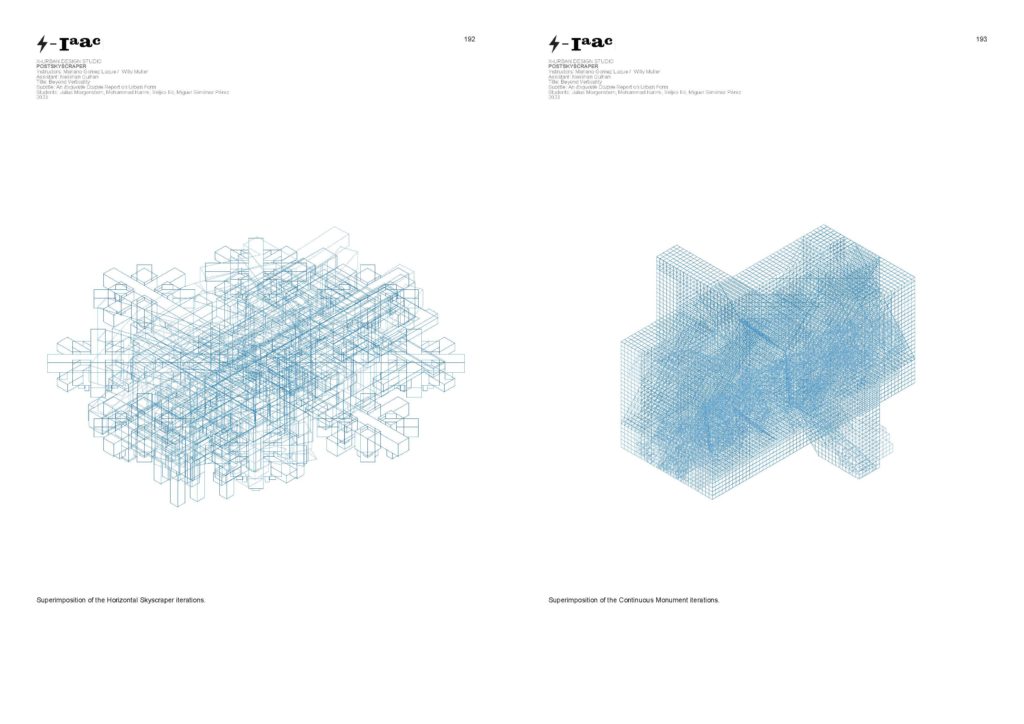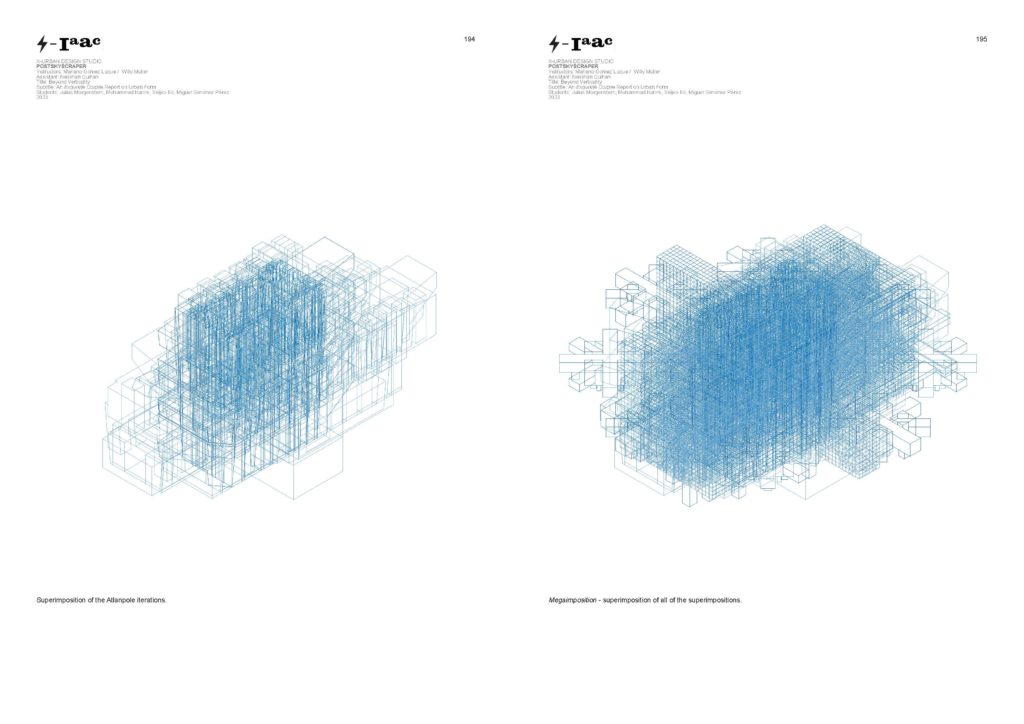An Exquisite Corpse Report on Urban Form
ABSTRACT
Introduction
With our work in this term we produced a multitude of drawings and images, watched and analyzed multiple movies, read multiple texts and came up with iterations and speculations. The common through line of all of these was the exploration of the nature of beyond-vertical forms of buildings and their effects on urbanization. With this in mind we view our work as research in these topics which we assembled in the form of an Exquisite Corpse – an originally surrealist game, in which multiple people add different things to one idea, such as a drawing, text, etc. – and reflected on all of our materials by organizing the chapters by the type of media. This allows us to present and visualize their multitude and diversity, and creates an interesting exploration of post-verticality and urbanism through a variety of media.
Beyond Verticality
The connective tissue and overarching narrative of the project is its reflection on new and different forms of verticality that go beyond the traditional cityscapes of skyscrapers. The problems of the mainly vertical urbanism of today become more and more apparent and we wanted to research alternatives presented in literature, cinema and both realized and hypothetical precedents. We explored a variety of different ideas that all have their own perception of how future urbanism could and possibly should or should not look like and build both a catalog of knowledge and base for our own speculations
Speculative Iterations
A big part of this project are the iterations of our case studies which produced catalogs of speculative compositions that take the logics of the case studies, change them and attempt to create new forms of buildings. We specifically tried to not think about these catalogs too much and rather chose to simply work with changes of logic producing uncertain and sometimes unexpected outcomes. This enabled us to free ourselves from the traditional, problem-solving approach to architectural design and follow a different process, producing different designs and drawings. In these catalogs we explored different compositional methods such as working with linearity and the oblique, modularity and the arrangement of masses.

DISPLAY OF THE FRAMES
Exposition of urban complexes
As we immerse ourselves in sci-fi movies, we are often captivated by the futuristic cities that the filmmakers imagine. We become engrossed in the intricate details of these urban landscapes, analyzing their complexity and visualizing what life might be like in such a world. Watching Metropolis, Blade Runner, and Blade Runner 2049 allowed us to explore and examine the imagined urban environments in an impossible way. By inspecting the frames, we gained a greater understanding of the urban complexity imagined in these films. This analysis of futuristic sci-fi cities could also benefit real world urban planning and design. By examining the imagined urban environments in these movies, we can gain new ideas and inspiration for creating more efficient and sustainable cities in our world.
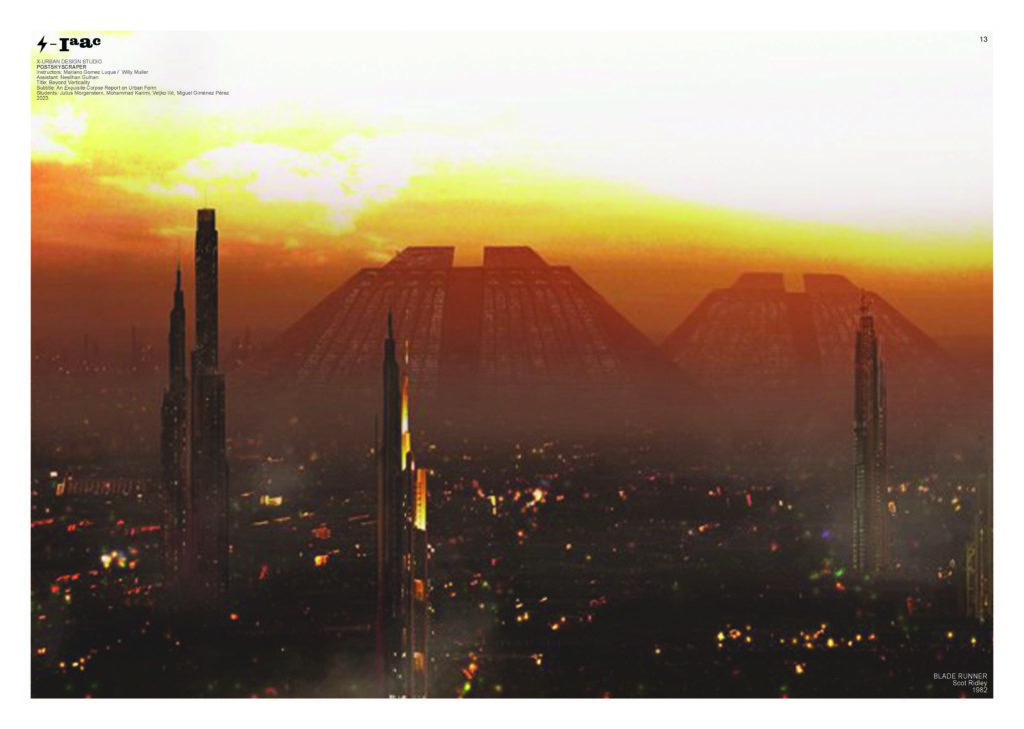
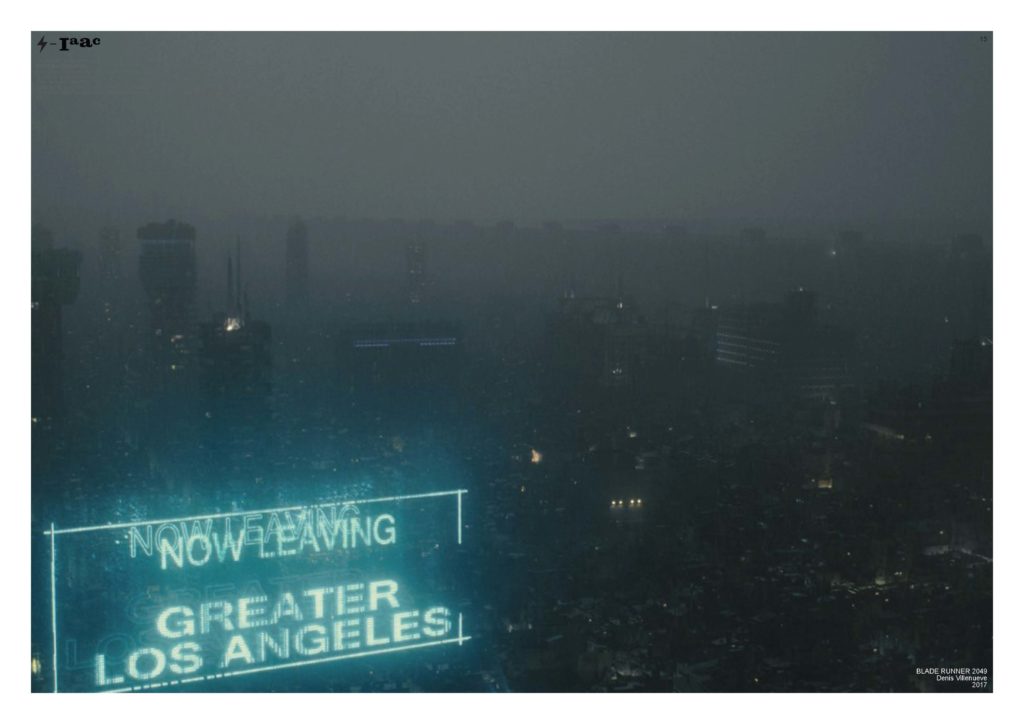

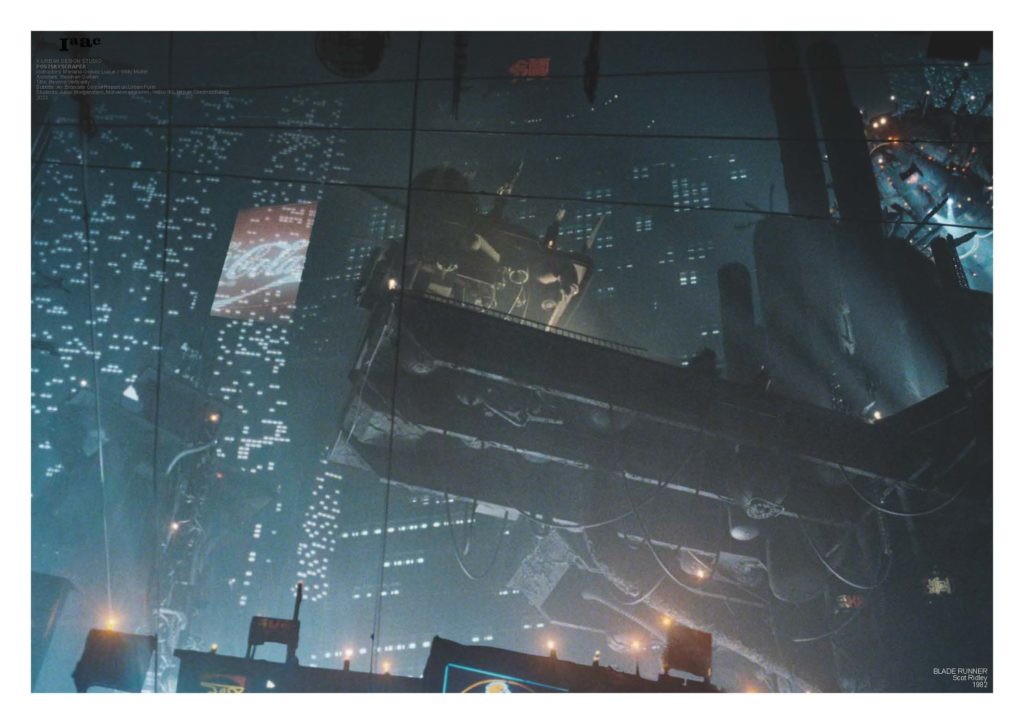

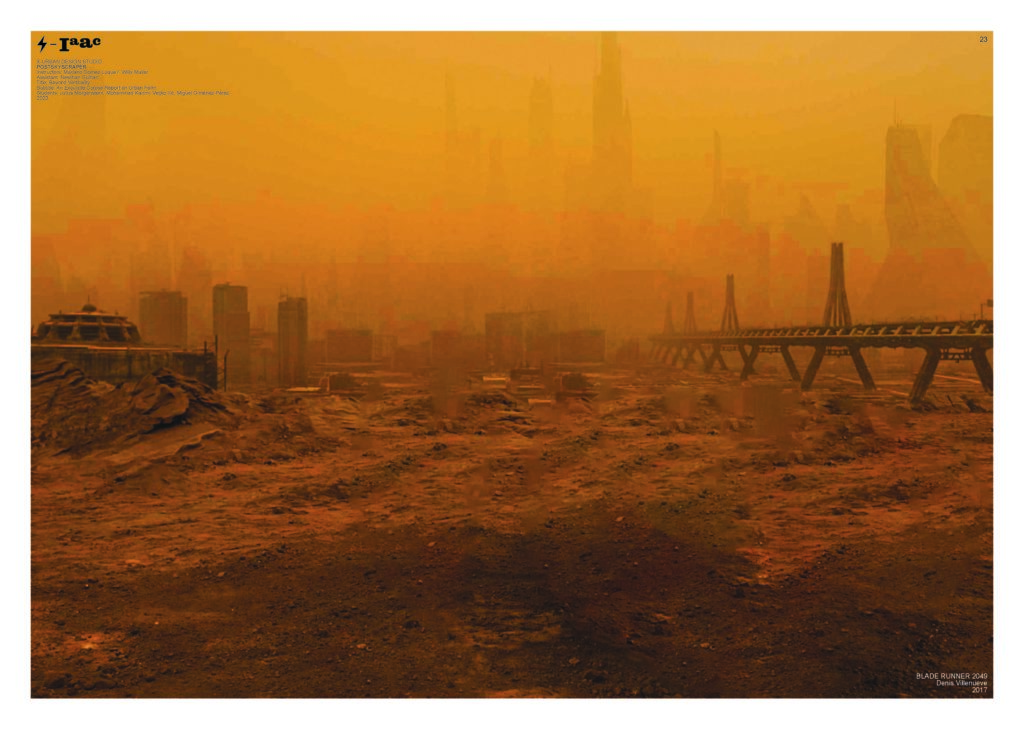
WORLDS REIMAGINED
Generating AI images of the cities
Combining the frames from Metropolis with different sci-fi movies is a conceptual idea that explores the possibilities of using existing visuals in new and creative ways. By combining frames from various films, new narratives and imagery are created, and more futuristic scenes are depicted. Moreover, this approach can help expand and enrich the visual language of science fiction films. Since the Blade Runner movie from 1982 was filmed in Los Angeles, many buildings in the movie are a reimagination of the existing buildings from the city. In this task, we attempted to reimagine real-life Los Angeles in the same way 40 years later, using modern technologies. Overall, the project aimed to create an otherworldly version of Los Angeles that resembled the futuristic, dystopian city portrayed in Blade Runner. Using the frames from the movie Blade Runner 2049, we explored what a future cityscape might look like. Not only that we want to explore how landscapes might be shaped by constant climate change and natural disasters, but also we visualize how the cities could become a landscape themselves or the landscapes to be transformed into the city. Striving to examine how the cities will shape the future of our planet and how they might interact with the surrounding landscape, we created a vision of a world where cities have spread across vast areas of the earth.

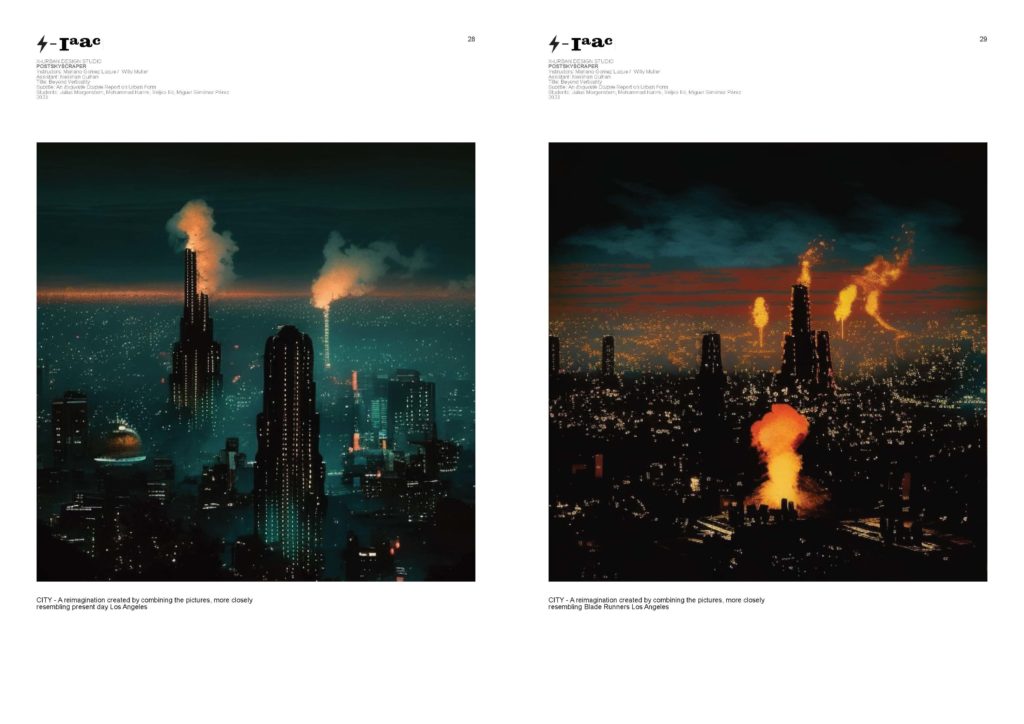

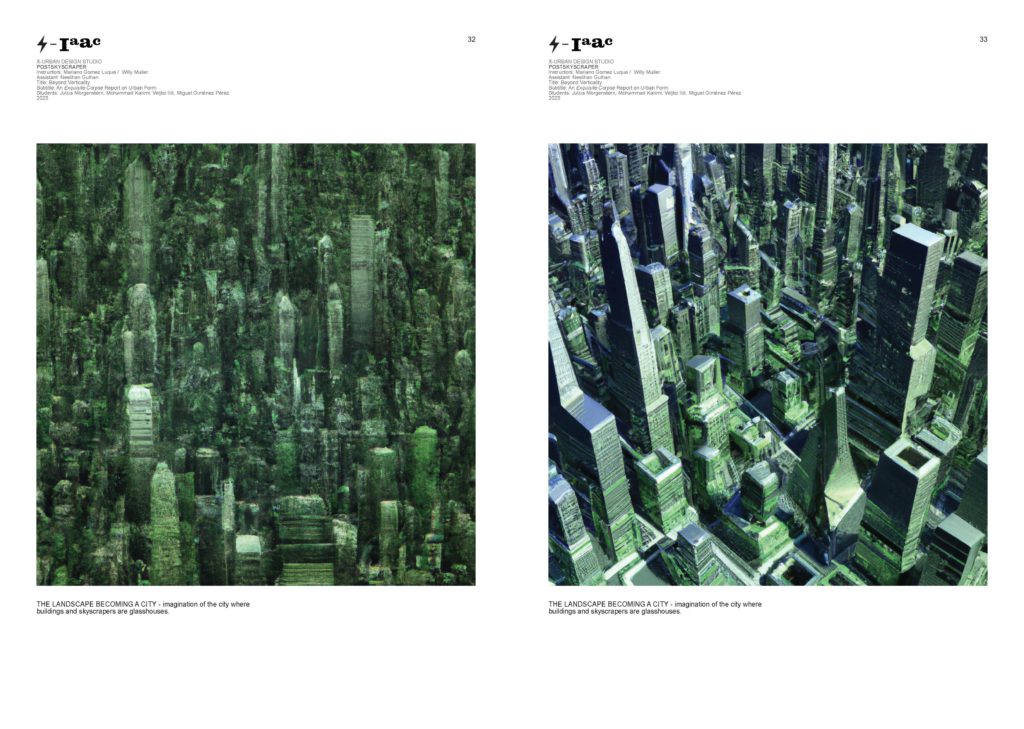
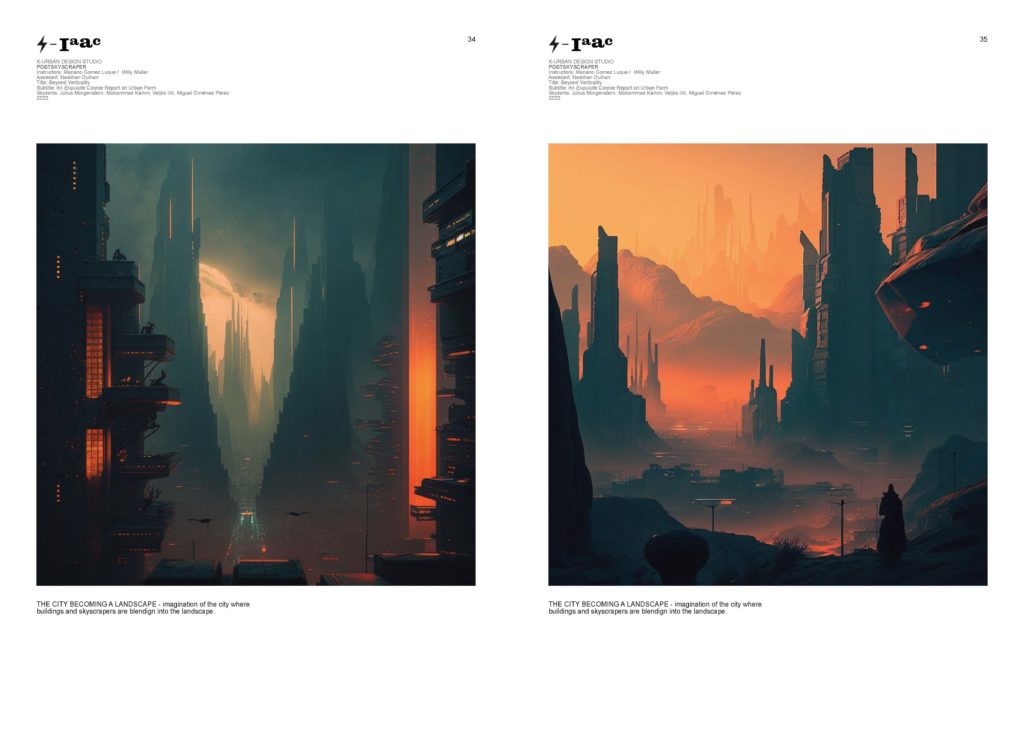
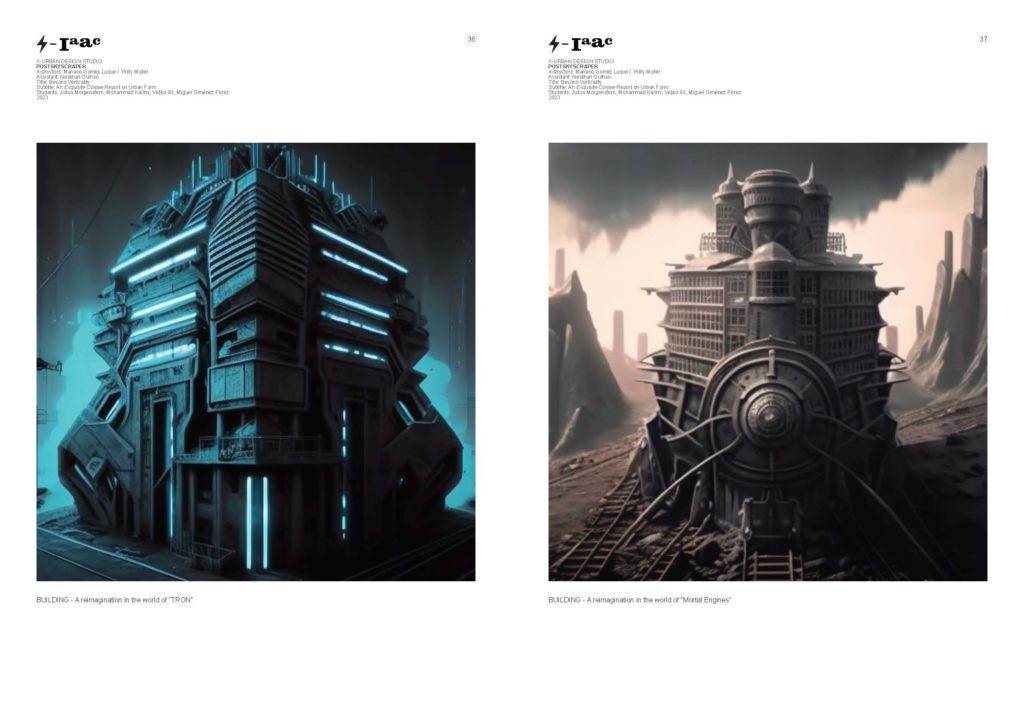
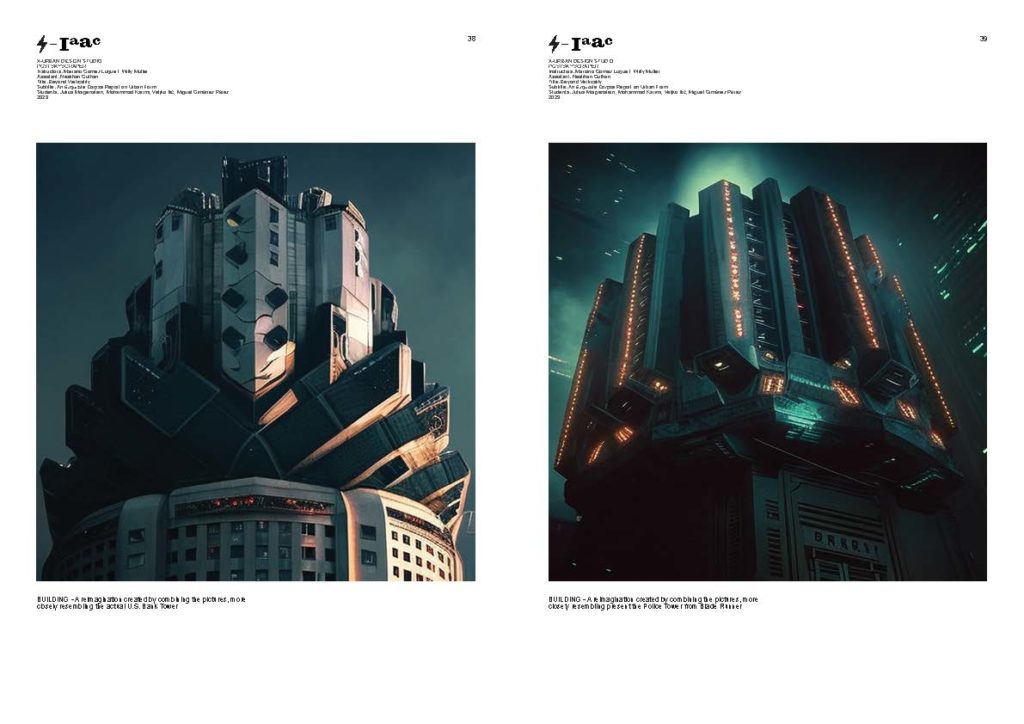
WORLDS RECREATED
Creating new scenarios using AI images
By overlapping existing AI images, we created new visions of what the future could look like, with possibilities that were once unimaginable. This technique allows us to combine different elements from various sources and generate unique and innovative designs that could inspire architects and city planners in the future. We aspired to align each element correctly so that the final product appears seamless and coherent.

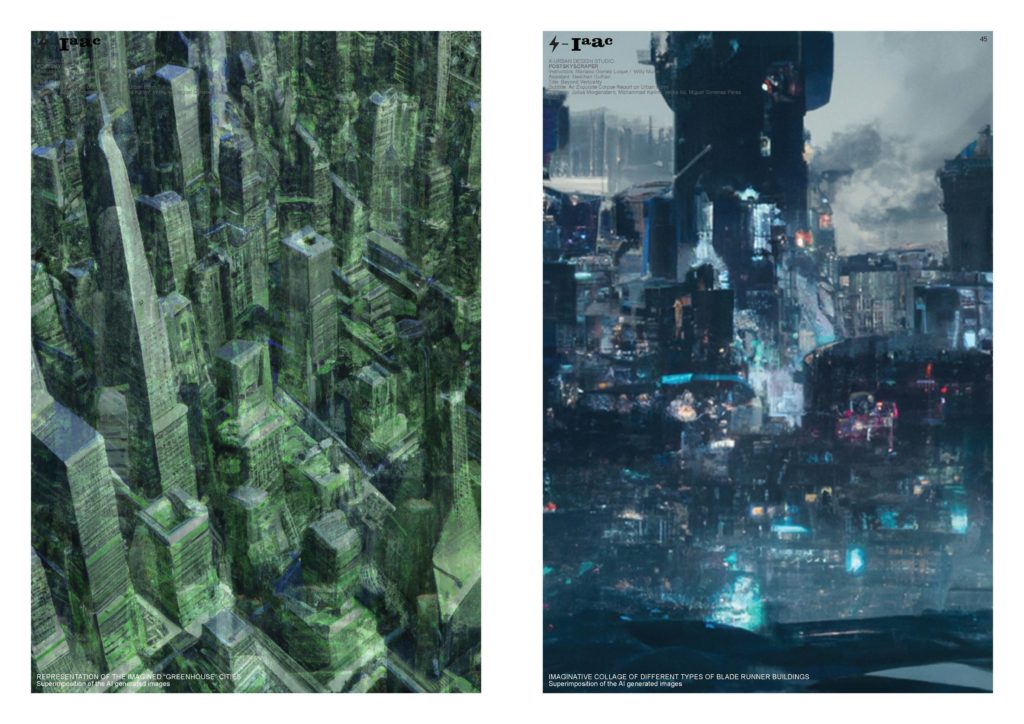
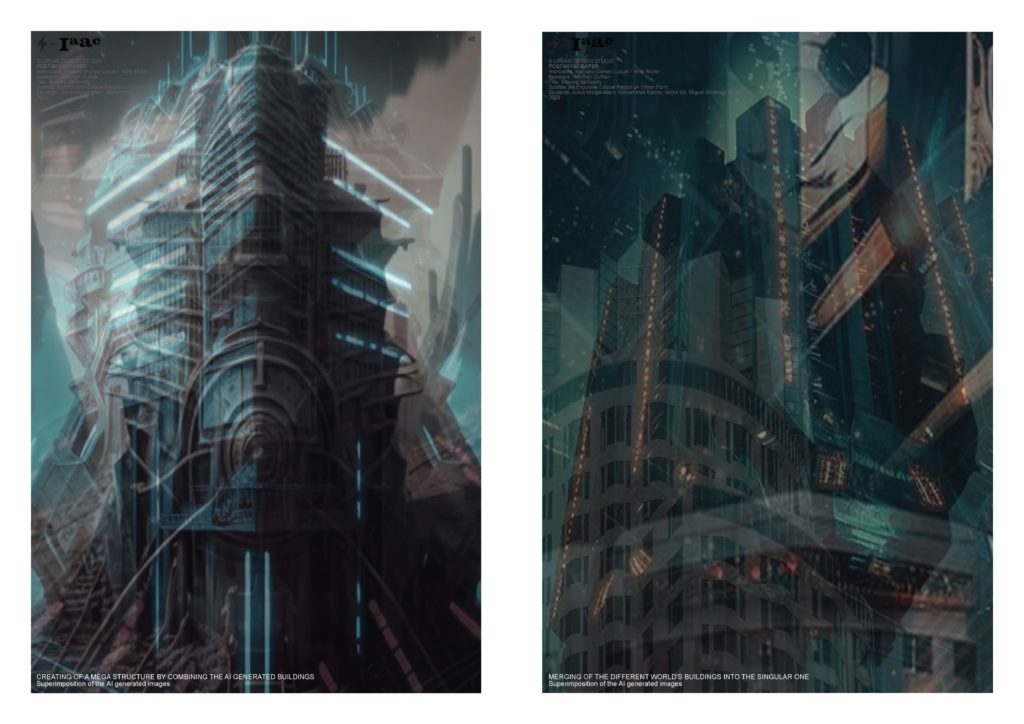
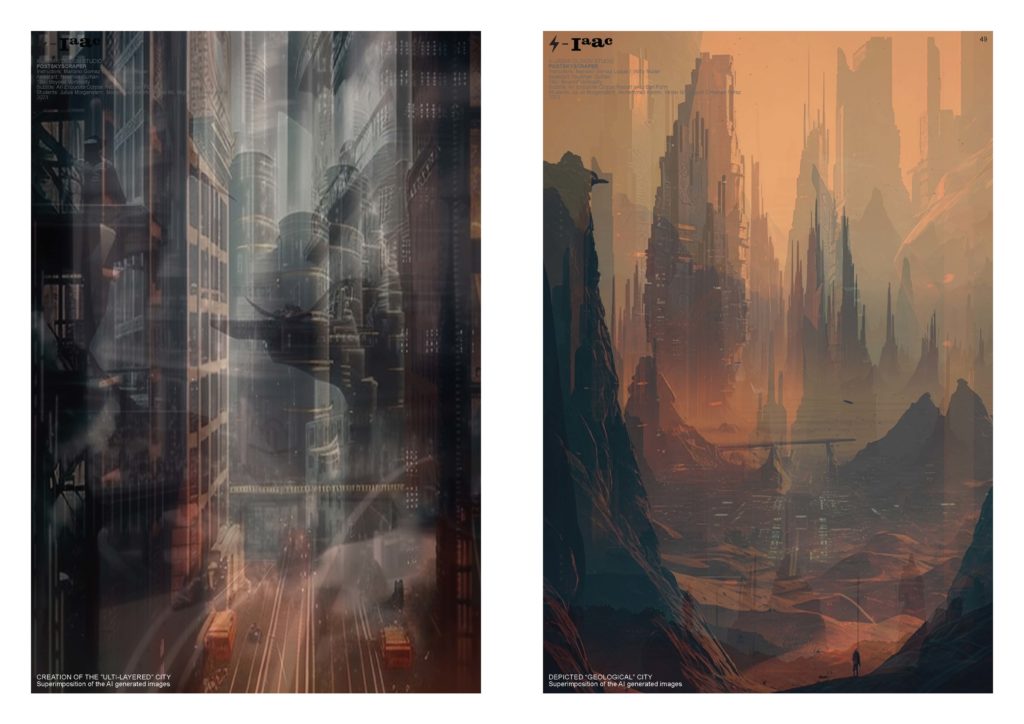
KEYWORDS AND QUOTES
BUILDING AS ABSTRACT OBJECT
UNEQUAL ECONOMICAL AND ECOLOGICAL EXCHANGE
GEOLOGICAL (-LY BASED) ARCHITECTURE
CONVENIENT FICTION
ENVELOPMENT OF TERRITORIAL EXTERIORITY
GENERIC ARCHITECTURE
SUBLIME ARCHITECTURE
COMPLEXITY THEORY
POST-COMPOSITIONAL ARCHITECTURE
ELEVATOR
RANDOM CIRCULATION
MECHANICAL CONNECTIONS
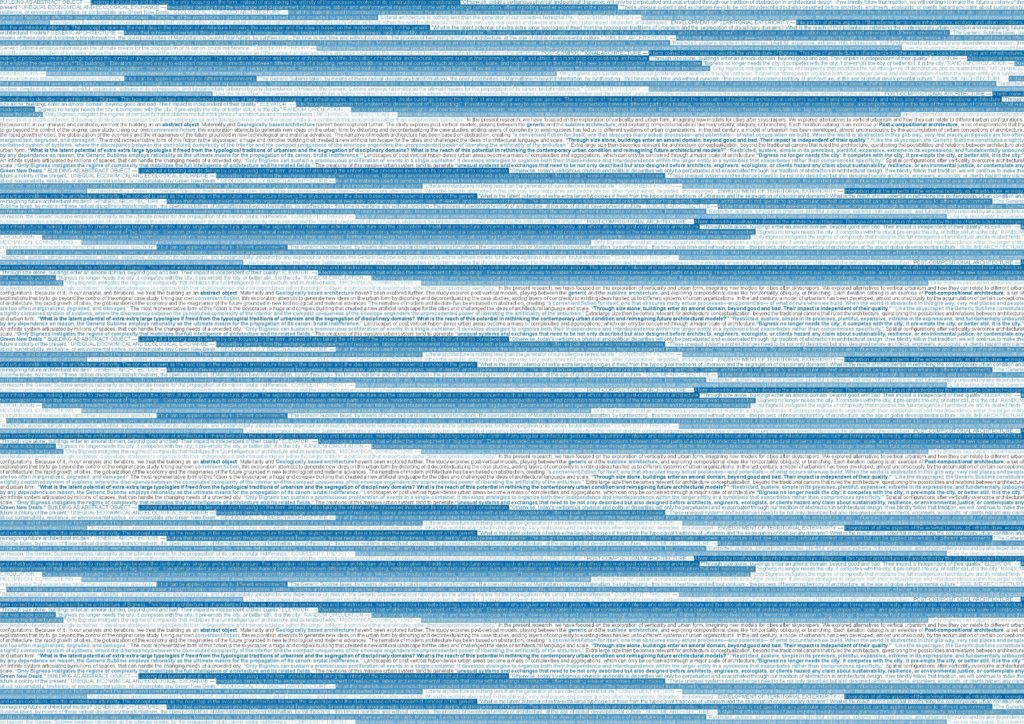
BUILDING AS ABSTRACT OBJECT — Looking at a building and its design by only focusing on the form, instead of also taking the entirety of the processes involved in its construction into consideration.
UNEQUAL ECONOMICAL AND ECOLOGICAL EXCHANGE — Inequalities deriving from the exchange and displacement of resources, labor and environmental impacts that come with a building’s construction, often exploiting weaker economies in the process.
GEOLOGICAL (-LY BASED) ARCHITECTURE — As all the materials used in construction are extracted from the ground, the buildings are nothing less than a unison of the fragments excerpted from the earth, water, forests and mountains. By extension, the architecture is also influenced by geology, as the choice and availability of materials, the site conditions, and other geological factors can affect the design and construction process. Therefore, all the architecture is geological since it is based on and impacted by geological factors.
CONVENIENT FICTION — Narrative that infiltrates the architectural discourse, focusing on and legitimizing abstraction that allows architectural design to ignore the ecological, social and political processes (and potentials) of building.
ENVELOPMENT OF TERRITORIAL EXTERIORITY — Integration of all the aspects of the external territory, as infrastructure, ecology, and urban conditions, into the architectural interiority. The concept is seen as the next step in the evolution of architecture following the skyscraper and the idea is based on the modernist concept of the generic.
GENERIC ARCHITECTURE — A style that achieves universality through organizational homogeneity, formal neutrality, programmatic blankness, lack of identity, and insipidness of character. The design focuses on functionality and practicality rather than aesthetics. Generic architecture is not specific to any particular context or location but can be applied universally to different environments.
SUBLIME ARCHITECTURE — A style that attains a sense of awe-inspiring beauty, power, or grandeur through its scale, complexity, and expressive qualities. Sublime architecture often uses large-scale and dramatic elements, such as sweeping curves, towering heights, intricate details, and striking colors, to create a sense of drama and theatricality. Moreover, it aims to elicit intense emotional responses from the viewer, whether it be a sense of peacefulness, fear, or reverence.
COMPLEXITY THEORY — Study of complex systems that examines uncertainty and non-linearity, emphasizing interactions and the accompanying feedback loops that constantly change them and proposing that systems are unpredictable but also constrained by order-generating rules.
POST-COMPOSITIONAL ARCHITECTURE — A term coined by Koolhaas to describe the architecture of Bigness. This type of
architecture is characterized by the use of large-scale technologies and infrastructures, making it possible to create buildings beyond the control of any singular architectural gesture. The separation of interior and exterior architecture and the dislocation of traditional architectural concerns such as transparency, honesty, and ethics also mark post compositional architecture.
ELEVATOR — A technological invention that enabled the development of “big buildings”. Elevators provided a way to establish mechanical connections between different parts of a building, rendering traditional architectural concerns such as composition, scale, and proportion moot in the face of the new scale of construction that was made possible.
RANDOM CIRCULATION — Due to conceptual breakthroughs and new technological inventions, new ways people and goods move through buildings are created. Rather than following fixed routes or hierarchies, circulation in “big buildings” became more fluid and open, reorganizing the social interactions and the program inside the building.
MECHANICAL CONNECTIONS — mobile intermediate spaces, created by mechanical devices, that allow fast transitions between the autonomous parts of a building, challenging classic architectural base concepts like composition, scale, proportion or detail.

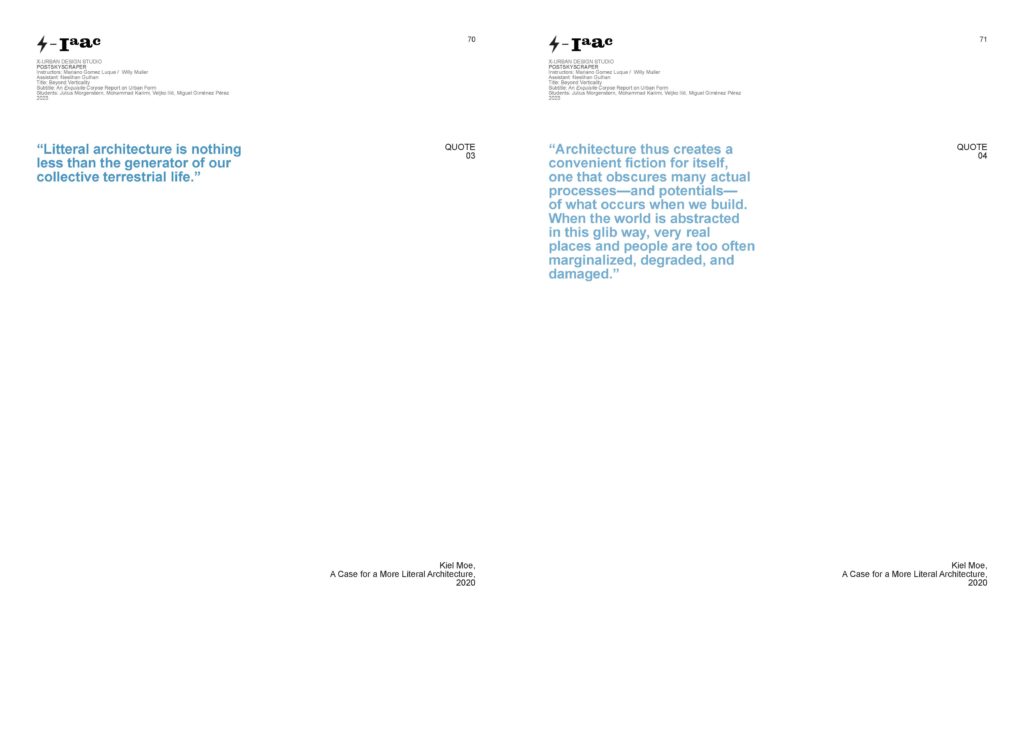


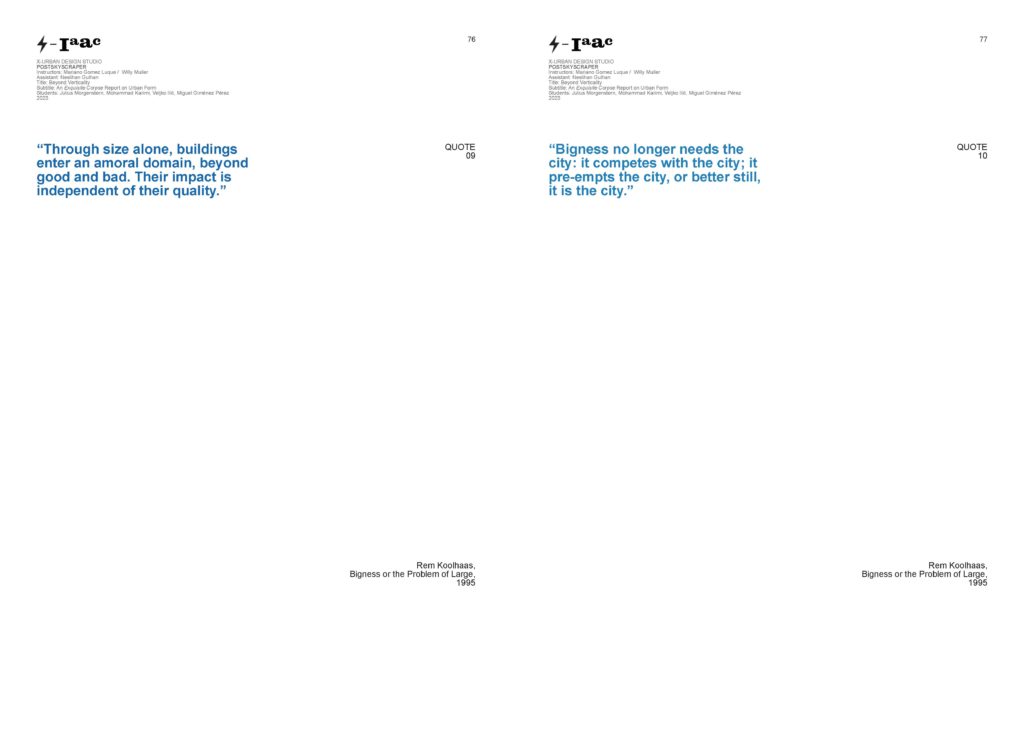

AN EXQUISITE CORPSE OF NARRATIVES
Following the concept of the exquisite corpse that has constructed the narrative of this booklet, we decided to do a final exercise of distortion and mutation of the text concepts. As we did with the images and the case study iterations, this chapter attempts to decontextualize the keywords and
quotes extracted from the text and reassemble them again to create new meanings and narratives. The exquisite corpse of narratives is a conceptual exploration of the meanings of verticality and urban form, connecting the concepts we have been working with and the knowledge we have extracted from our experimentation with our final narrative.
In the present research, we have focused on the exploration of verticality and urban form, imagining new models for cities after
skyscrapers. We explored alternatives to vertical urbanism and how they can relate to different urban configurations. Because
of it, in our analysis and iterations, we treat the building as an abstract object. Materiality and Geologically based architecture haven’t been explored further. The study explores post-vertical models, playing between the generic and the sublime architecture, and exploring compositional ideas like horizontality, obliquity, or branching.
Each iteration catalog is an exercise of Post-compositional architecture, a set of explorations that try to go beyond the control of the original case study. Using our own convenient fiction, this exploration attempts to generate new ideas on the urban form by distorting and decontextualizing the case studies, adding layers of complexity to existing ideas has led us to different systems of urban organizations.
In the last century, a model of urbanism has been developed, almost unconsciously, by the accumulation of certain conceptions of architecture, the rapid growth of cities, the globalization of the economy and the imaginaries of the future grounded in new technological and material advances. The narrative of modern architecture has been based on abstraction, creating “a convenient fiction for itself, one that obscures many actual processes—and potentials— of what occurs when we build. When the world is abstracted in this glib way, very real places and people are too often marginalized, degraded, and damaged.” The most representative form of this fiction is the skyscraper, a huge and complex building that created a new artificial landscape for the cities and challenged the ideas of architectural language and scale. “Through size alone, buildings enter an amoral domain, beyond good and bad. Their impact is independent of their quality.” “Like the skyscraper, the Generic Sublime constitutes a tightly contained system of systems, where the discrepancy between the convoluted complexity of the interior and the compact uniqueness of the envelope engenders the unprecedented power of liberating the artificiality of the antiurban.” Extra large size then becomes relevant for architecture conceptualization, beyond the traditional canons that ruled the architecture, questioning the possibilities and relations between architecture and urban form. “What is the latent potential of extra extra large typologies if freed from the typological traditions of urbanism and the segregation of disciplinary domains? What is the reach of this potential in rethinking the contemporary urban condition and reimagining future architectural models?”
“Restricted, austere, simple in its premises, plentiful, expansive, extreme in its expressions, and fundamentally unbound by any dependence on reason, the Generic Sublime employs rationality as the ultimate means for the propagation of its canon: brutal indifference.” Landscapes of post vertical hyper-dense urban areas become a mass of complexities and aggregations, which can only be conceived through a major scale of architecture.“ Bigness no longer needs the city: it competes with the city; it pre-empts the city, or better still, it is the city.” An infinite system articulated by millions of spaces, that can handle the changing needs of a crowded city. “Only Bigness can sustain a promiscuous proliferation of events in a single container. It develops strategies to organize both their independence and interdependence within the larger entity in a symbiosis that exacerbates rather than compromises specificity.” Spatial configurations after verticality overcome architectural scale. “Only Bigness instigates the regime of complexity that mobilizes the full intelligence of architecture and its related fields.” The creations of this massive urban system tend to generate “unequal systems and exchanges that need to be not only described but also designed before architects, engineers, ecologists, or clients hazard any claim about sustainability, resilience, or environmental justice, or contemplate any Green New Deals.”
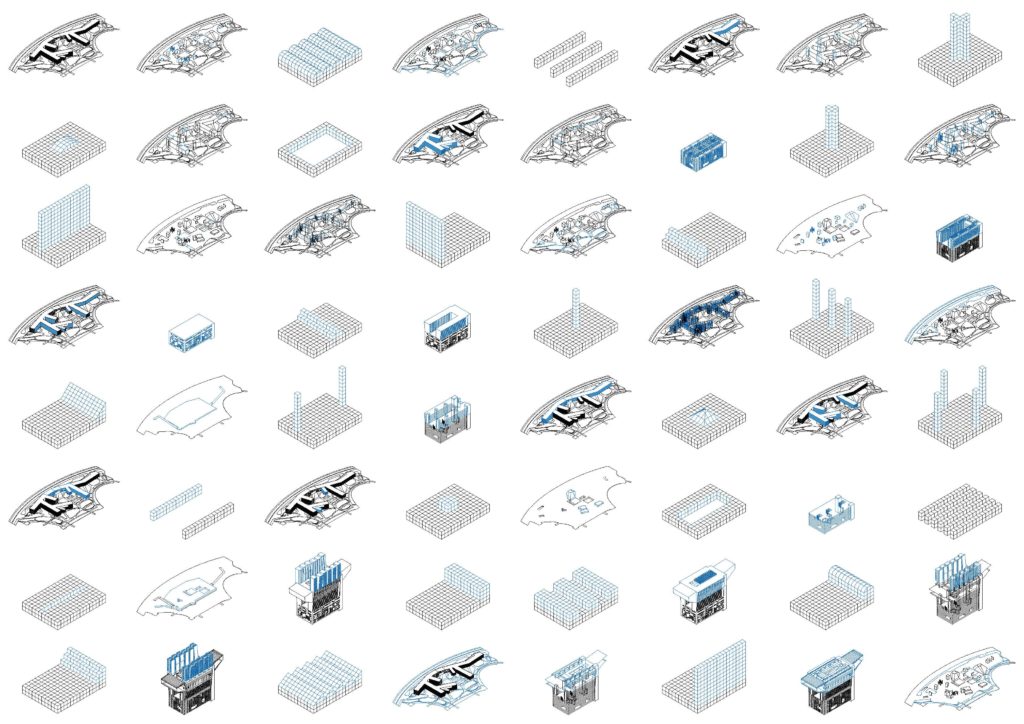
EXPLORATION OF LINEARITY
The Horizonal Skyscraper
Steven Holl is an architect known for his innovative and experimental designs. Through his projects and concepts, the idea of redesigning verticality into horizontality is continually noticeable. The Horizontal Skyscraper is a building that extends horizontally rather than vertically like a traditional skyscraper, with the goal of integrating into the surrounding landscape, rather than rising up and dominating it. It is the only realized project of the case studies we will be covering in this booklet. The “Vanke Center”, as it is also known, is located in China and was finished in 2008. It is a mixed-use building suspended above the ground but only rising to 35 meters. Underneath it features tropical gardens accessible to the public with the entire site reaching across 52.000 square meters. The building has between four and five stories which extends the entire area to 120.445 square meters.
Horinzontality and its impact on the Urban Form
With the Horizontal Skyscraper Steven Holl proposes a concept that goes beyond the traditional design of large buildings. Instead of rising above the surrounding context and dominating it, it is supposed to seamlessly blend into it by being suspended above the ground but stretching horizontally, rather than vertically. It is an interesting exercise in reconfiguring the program of skyscrapers to different typologies and its effect on the urban form. Steven Holl does not present a new type of urbanism, but rather a new typology which, if more prominent, would have significant impacts on it. As with many of Holl’s designs, it tries to blur the boundaries between the interior and exterior and aims to create a closer connection with the environment. The Horizontal Skyscraper is also supposed to represent the idea of a more human-scale and environmentally sensitive approach to building design, this narrative however still follows its own convenient fiction grounded in abstraction. While this concept is meant to question traditional skyscrapers and challenge conventional ideas about the role of buildings in the urban environment, it still follows the discourse of most modernist architecture.
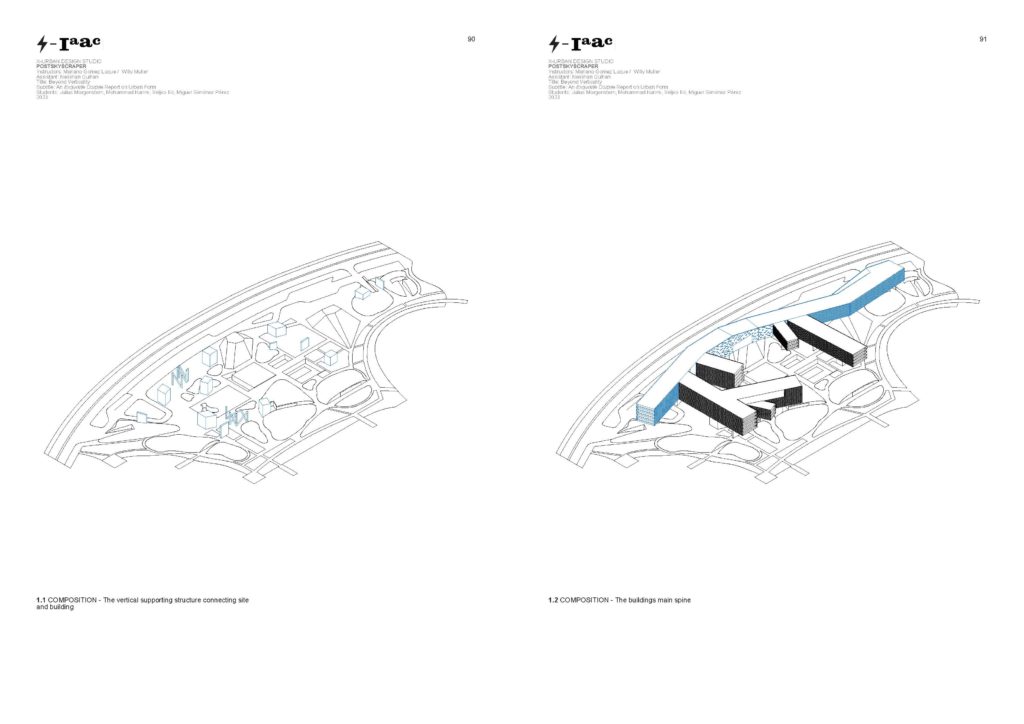
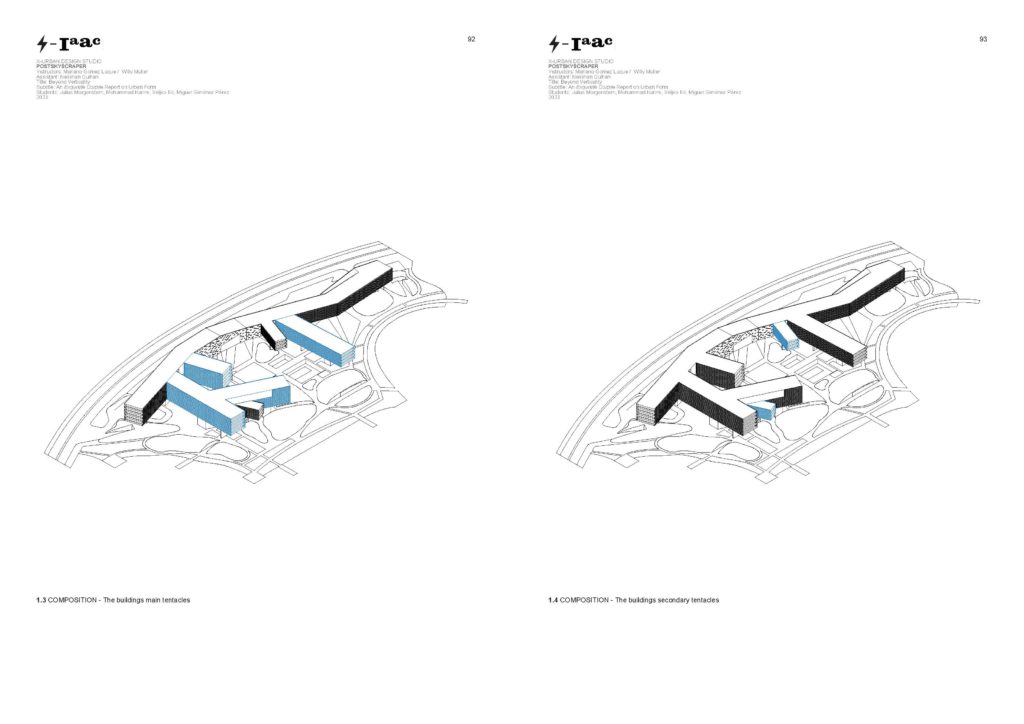
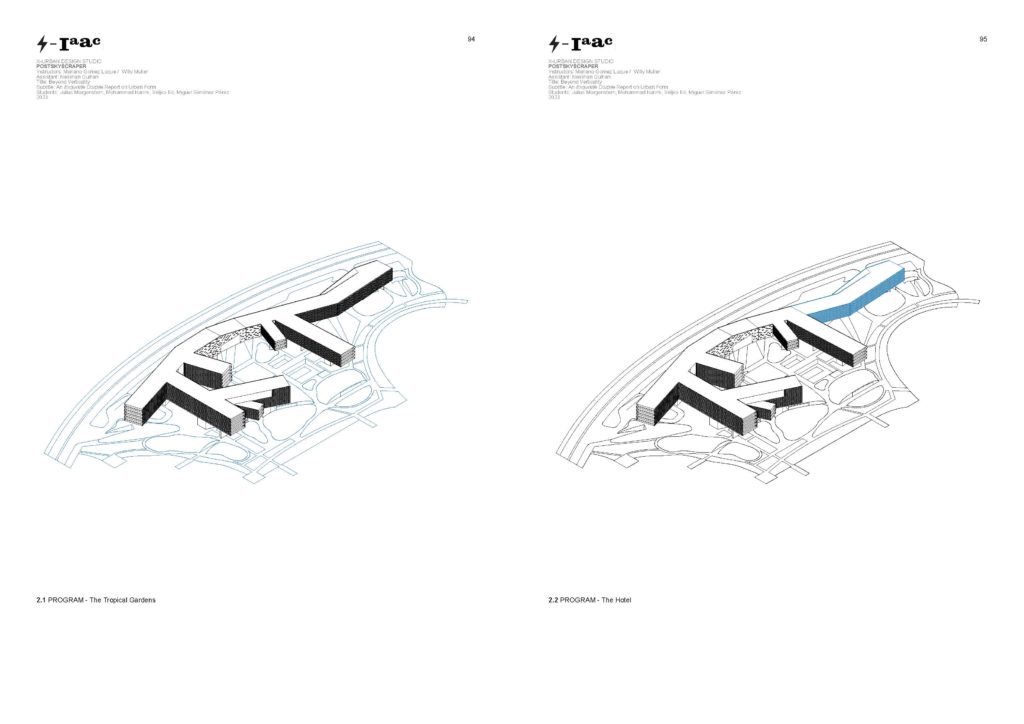

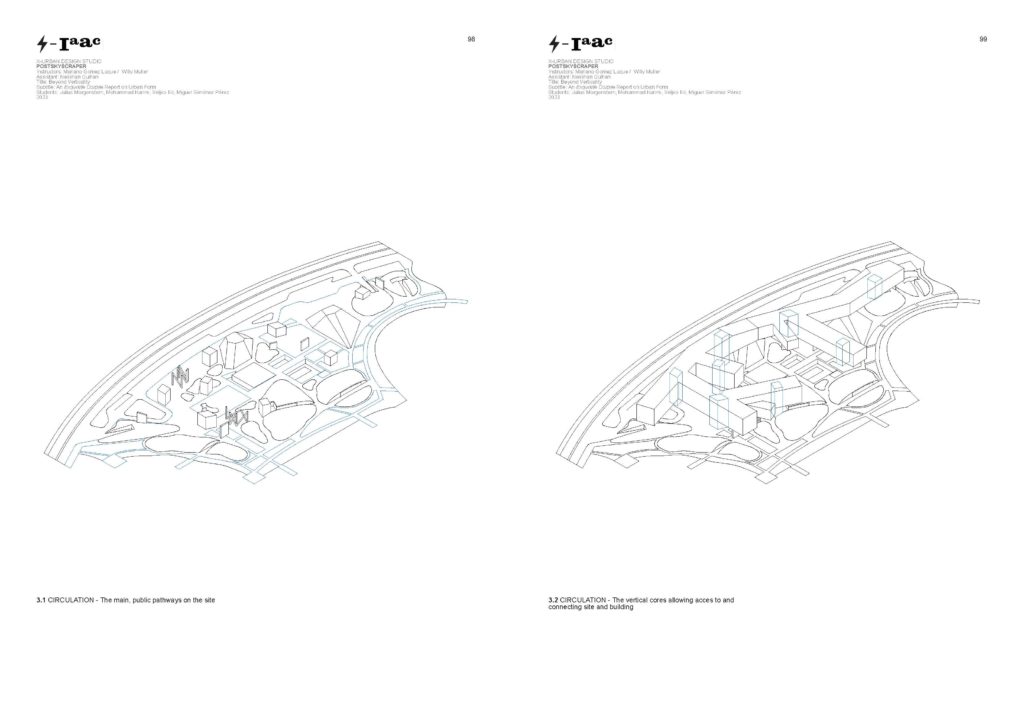

EXPLORATION OF CONTEXT
Analysis Catalogs
The goal of these catalogs was to represent the seemingly minor parts of the design and illustrate their impact on urbanism. For one, the open public site underneath the building features some tropical gardens and allows some light to pass through to the underground levels through courtyards and skylights. This is only possible because of the horizontal expansiveness of the site and would not be realizable in more traditional skyscraper design. On the other hand, while the site is supposed to be or represent and element of nature, it is entirely artificial in itself and the expansiveness more to its detriment, as it means significant impacts on the surroundings. Also, the reinforced concrete structure and the parking garages follow the very traditional logics of skyscrapers, and only provide an alternative on a superficial level.
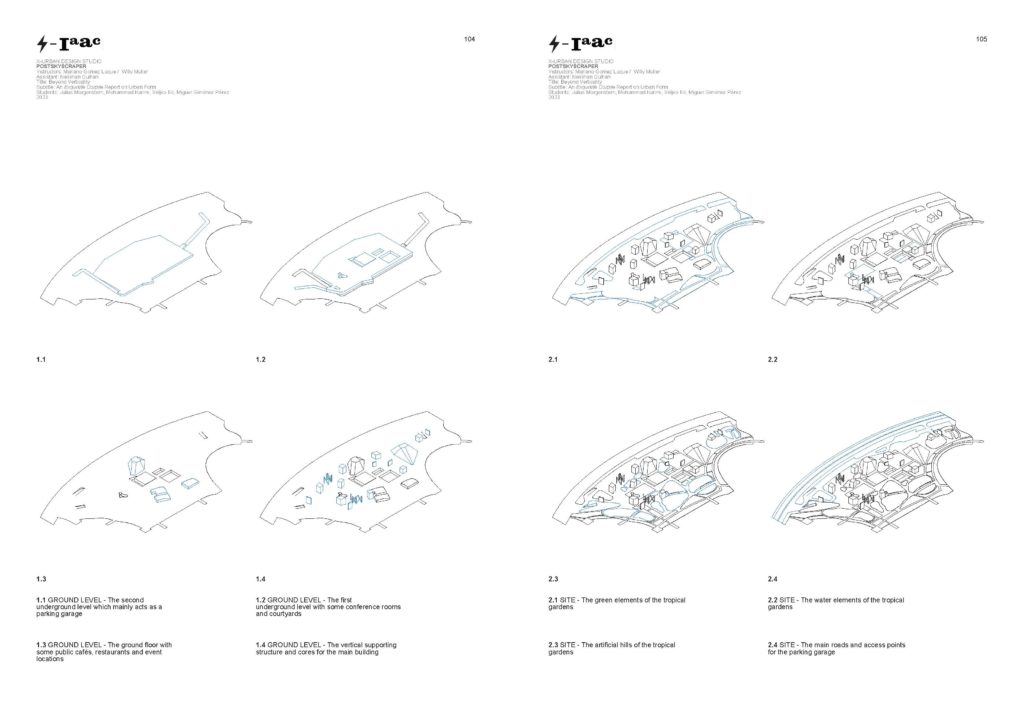

EXPLORATION OF MODULARITY
The Continuous Monument
The Continuous Monument is a conceptual design project created by the Superstudio in the late 1960s. It was a response to the perceived excesses of modernist architecture and the emerging consumer culture of the time. The Continuous Monument is a utopian vision of a single, massive structure covering the entire planet, creating a unified and homogeneous world without boundaries, where people would be unencumbered by national borders, cultural differences, or social hierarchies. The structure would be a sort of minimalist grid, comprising a series of square modules that could be endlessly combined and reconfigured. Hence, the structure would be an expression of pure, universal design, unburdened by the complexities of human culture. Despite its utopian aspirations, the Continuous Monument was also somewhat dystopian. The uniformity and monotony of the structure suggested a world without diversity or individuality, where everyone was subsumed into a single, homogeneous mass. The project was a reminder of the potential dangers of utopian thinking and the need to balance our desire for social and political change with recognizing the complex and messy realities of human life.
A Global Urbanization
Even though both of them feature strong horizontality, the Continuous Monument sets itself apart from the Horizontal Skyscraper (and in fact almost all other case studies), in that it does not necessarily represent an idea for a building but rather an expansive concept for urbanism in general. While the Horizontal Skyscraper merely represents a change of typology in a standard model of urbanization, the Continuous Monument suggests an entirely new, alternate idea of it. It does not exist inside the city, but rather parallel to it as its own, global structure.
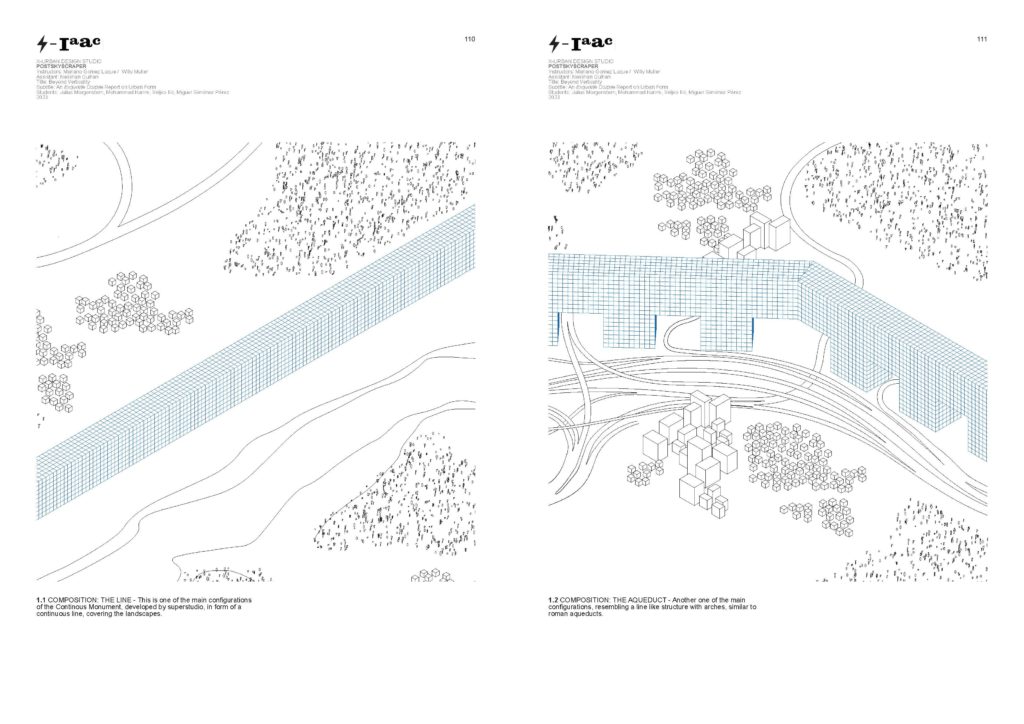

EXPLORATION OF COMPOSITION
Variations Catalogs
These are the original catalogs of Superstudio showing of different compositions and elements for the Continuous Monument. They showcase the supposedly large variety of different configurations that the modular system could adopt. This way, it should apparently fit into all contexts of more
traditional forms of urbanization by recreating their logics through its modularity. It however again mainly shows the standardized homogeneity of this model of globalization and its utter lack of diversity.
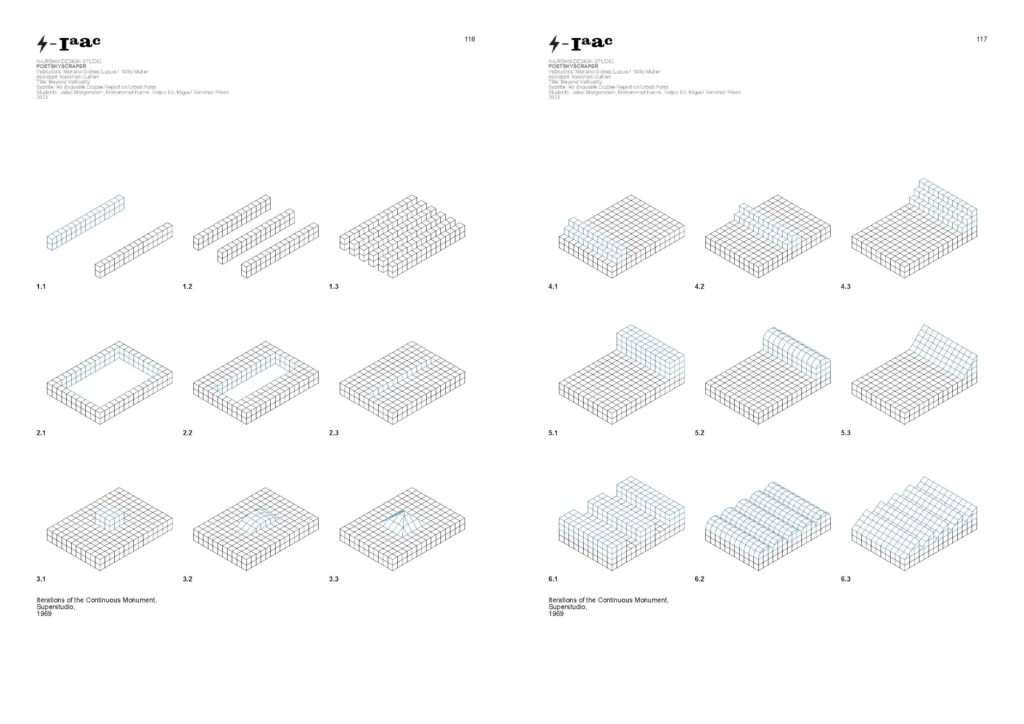
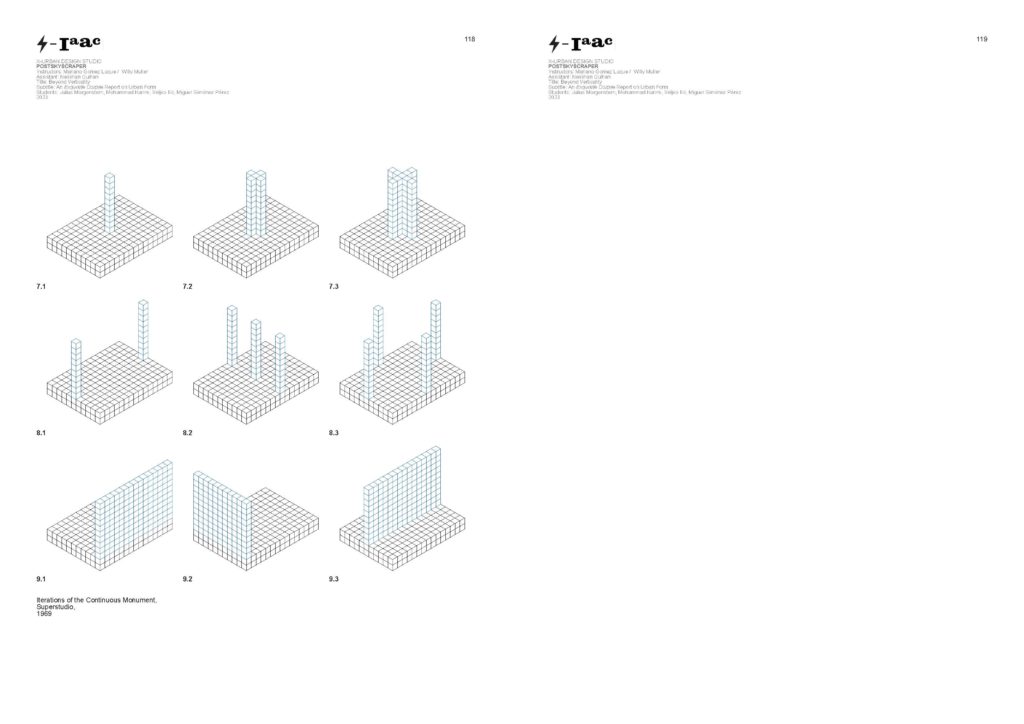
EXPLORATION OF MASS
The Atlanpole
In 1988 Hans Kollhoff submitted his proposal for the “Technopole” competition titled “The Compact City of Atlanpole.” Proposed to be located in the city of Nantes, France, the project consists of an extensive mixed-use development focused on creating a vibrant and sustainable urban nvironment.
The design, conceived as an urban center with research and teaching facilities for highly specialized industries, is a large building that contains the “energy” of an entire town and stands alone in the countryside. It is designed to be a self-contained community, with residential, commercial, and cultural spaces all integrated into a single development. The project features a variety of different building types, including high-rise towers, low-rise apartment buildings, and townhouses, all arranged around a central plaza.
“New technology will make it possible to live and work in the same area at the same time. A greater need for informal personal contact in the private sphere will contrast with the tendency towards specialization at work. This will give rise to the idea of a compact city.”
– Hans Kollhoff, 1988
Frankensteins Urban Model
While not traditionally vertical, the Atlanpole again represents a completely new model of urbanization, compared to both the Horizontal Skyscraper and the Continuous Monument. Both of them still work within the existing context, the one integrating into it, the other one dominating and paralleling it, whereas the Atlanpole presents an autonomous model of urbanization by condensing an entire city into one building. While it still
works more or less within the confines of buildings and cities, it basically turns the matrix on its head by creating a building made out of a city instead of the other way around. The most interesting part is that this new model of urbanization can be expanded and adopted as its compositions mirrors the different elements of the city and even in this way mirrors the layout of cities, as a sum of their different parts, albeit stacked vertically
rather than horizontally.
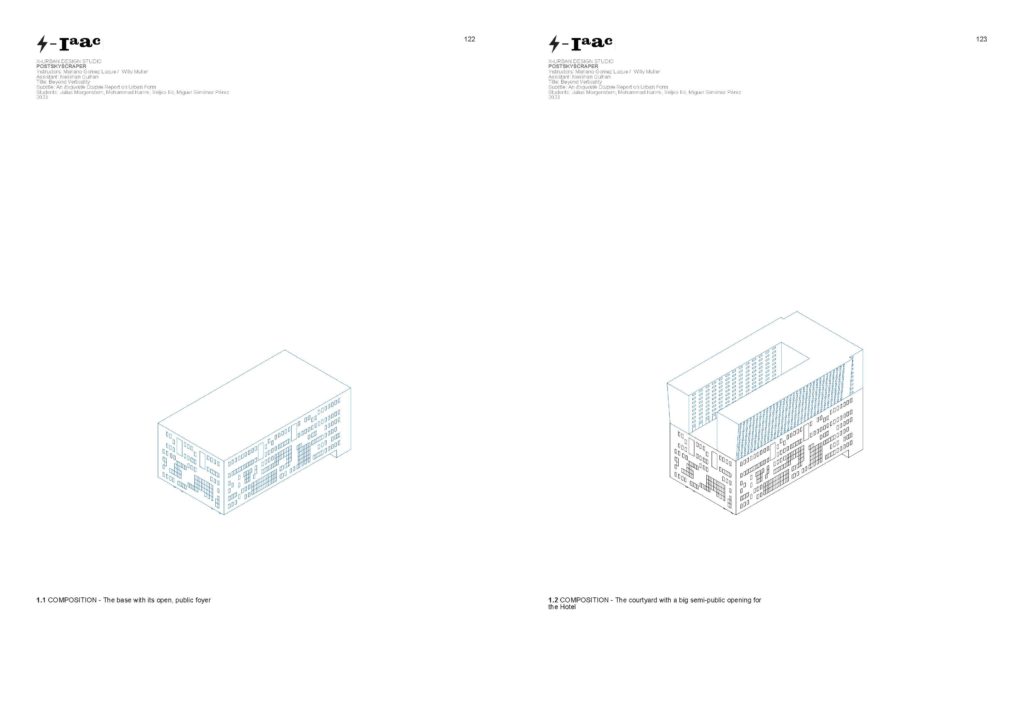
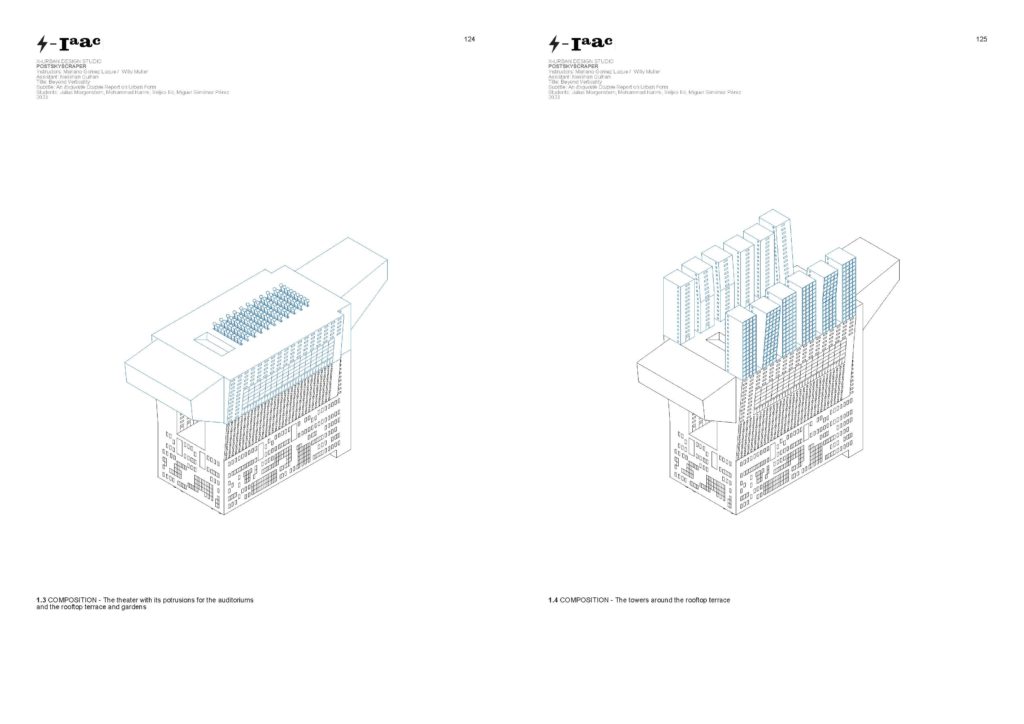
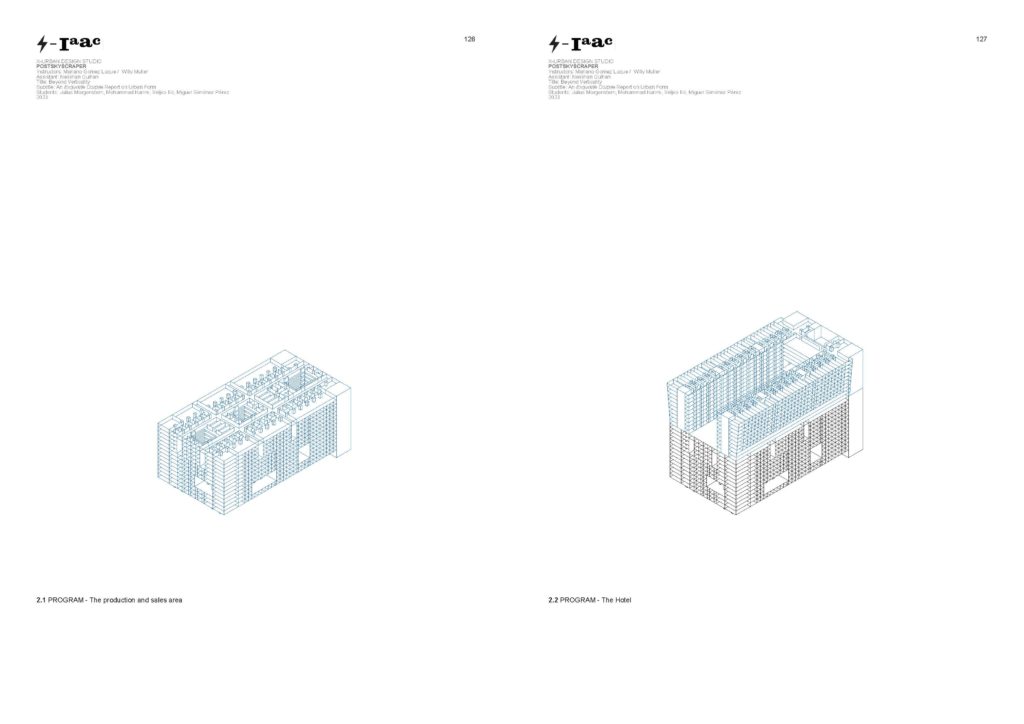
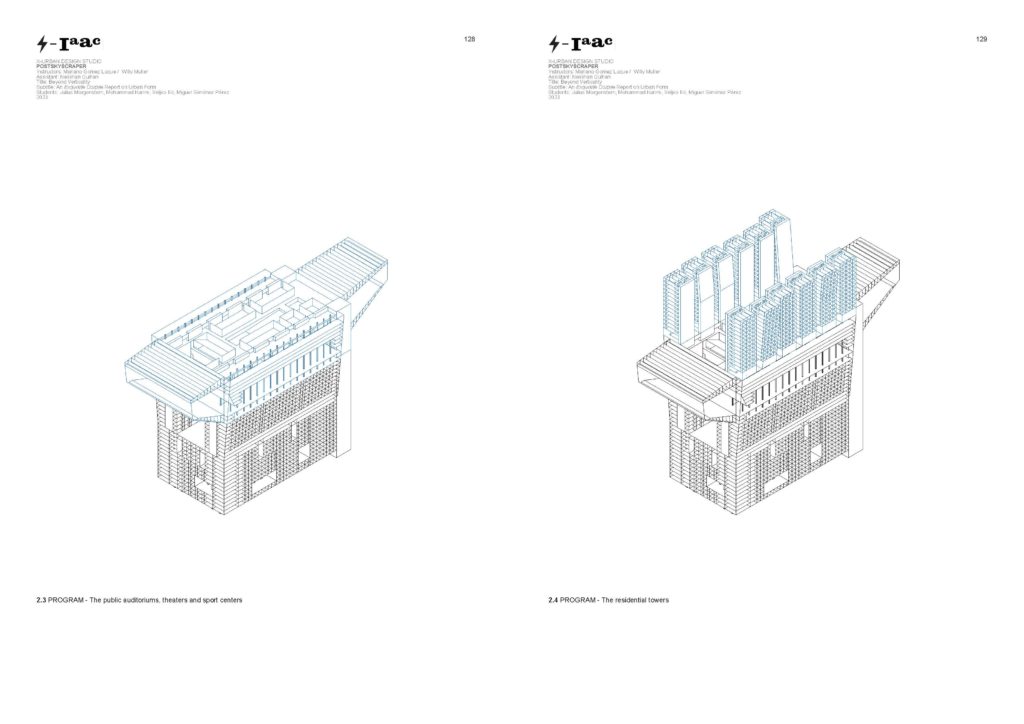
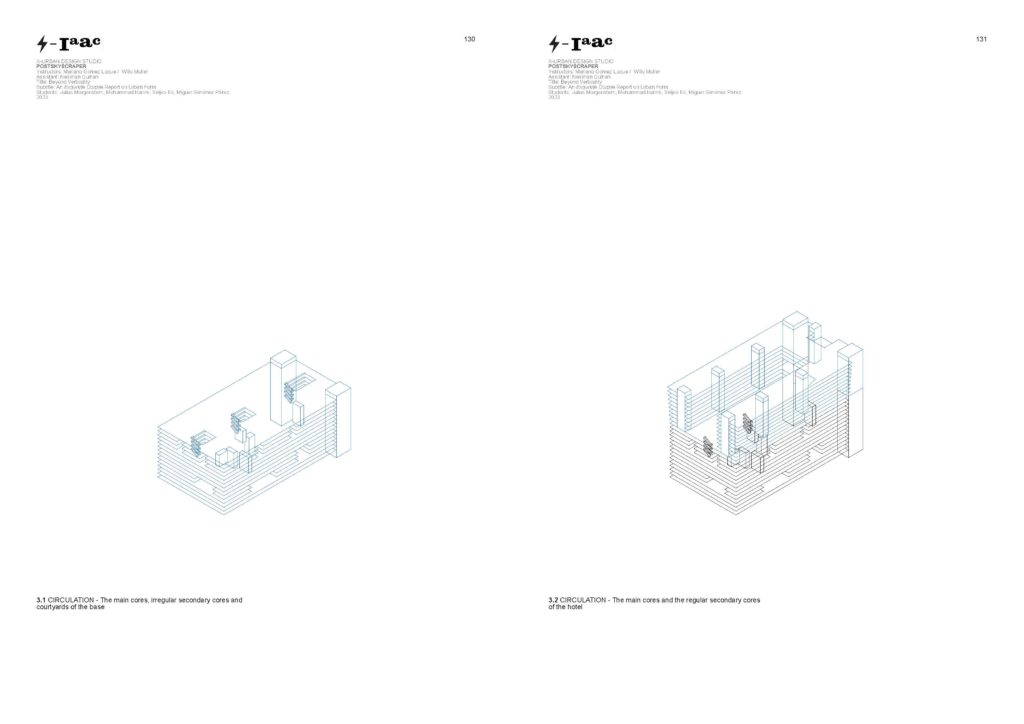

EXPLORATION OF VOIDS AND MASS
Section Catalogs
These catalog showcase the relationship between the voids and mass inside the Atlanpole, which act as public and private spaces accordingly. The interesting part about their composition is the translation of the layout of cities into voids and masses of a singular building. Instead of plazas, it features open floors, instead of gardens it has a rooftop terrace, instead of highways it has elevators and cores. This is a very interesting reimagination of urban composition into building design and unique among the case studies.
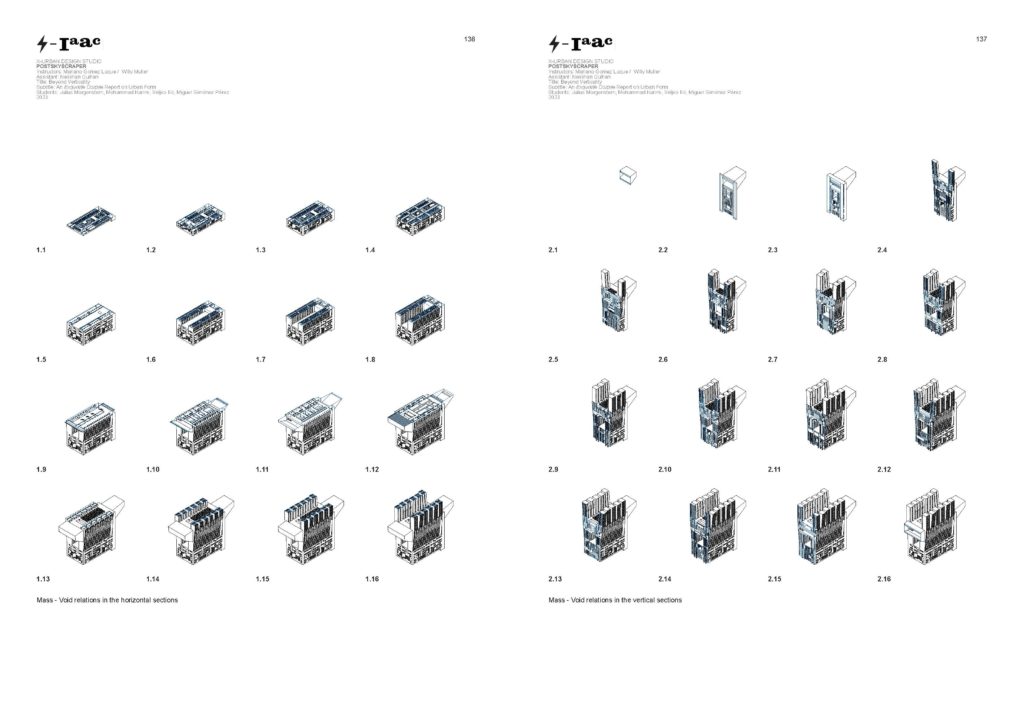
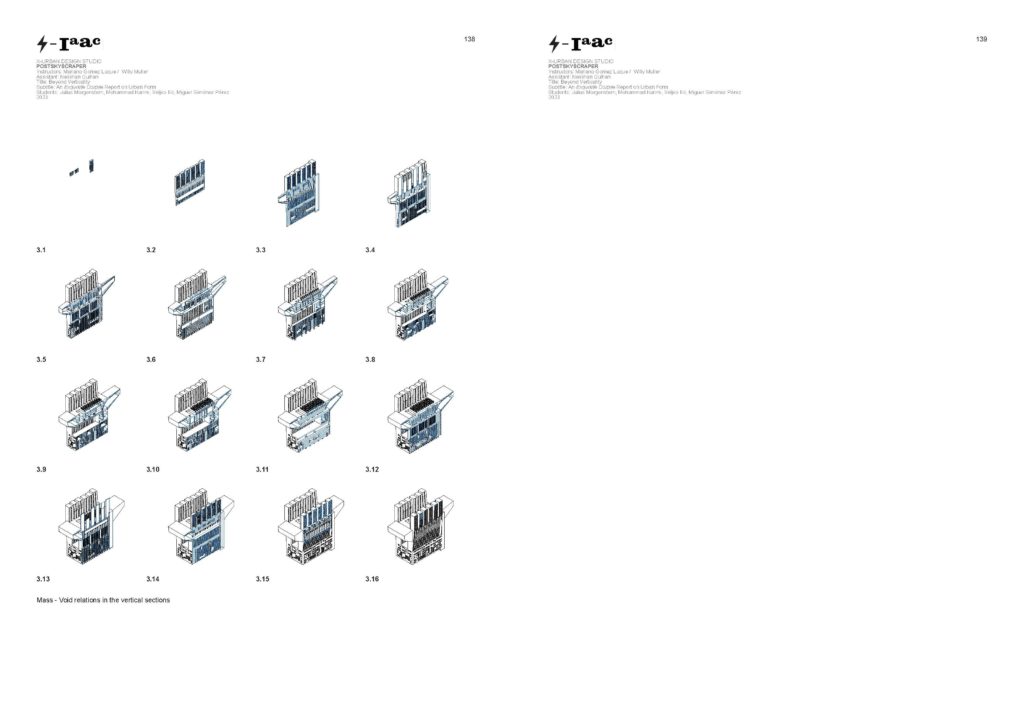
EXPLORATION OF PRECEDENTS
These are some minor explorations of more concepts of traditional skyscrapers, also informing and building the base for our catlaog of iterations of the Horizontal Skyscraper by Steven Holl. Other than the Gymnasium Bridge they are from the early 20th century and feature very interesting ideas and models of urbanization, also found in the case studies. While the Wolkenbügel by El Lissitzky clearly informs Steven Holl’s later designs, such as the hypothetical Gymnasium Bridge and the Horizontal Skyscraper, Hellytown builds the base for ideas like the Continuous Monument, and Frederick Kieslers design beards some resemblance to the autonomous centrality of the Atlanpole. They all present interesting models of urbanization beyond the vertical and are an interesting addition to our explorations.
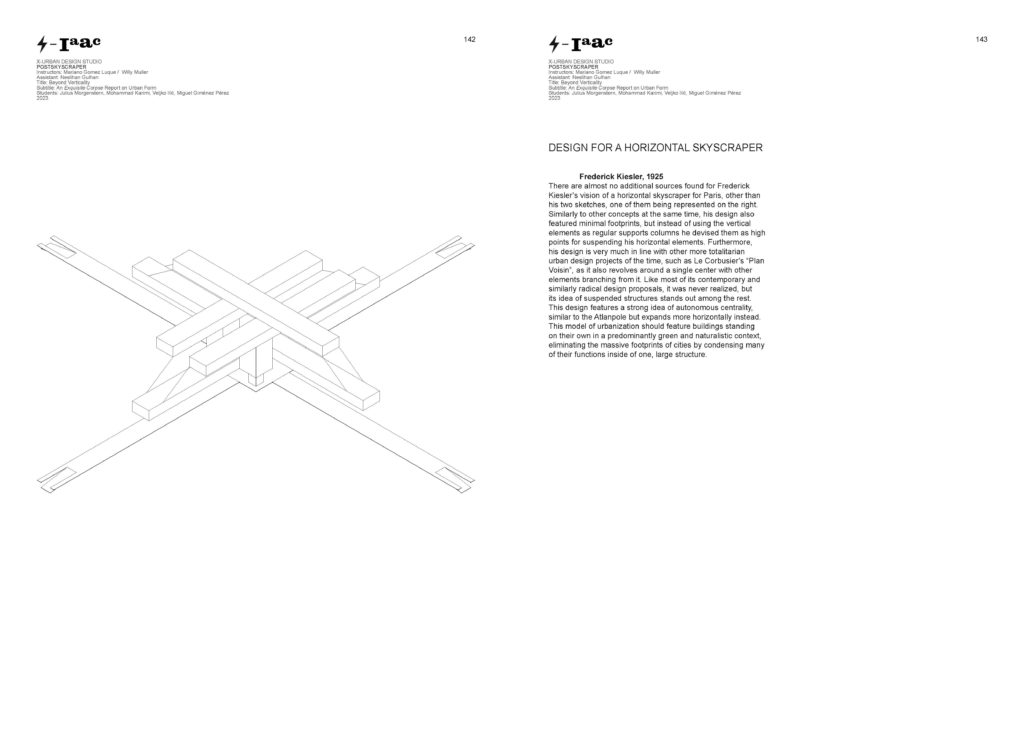
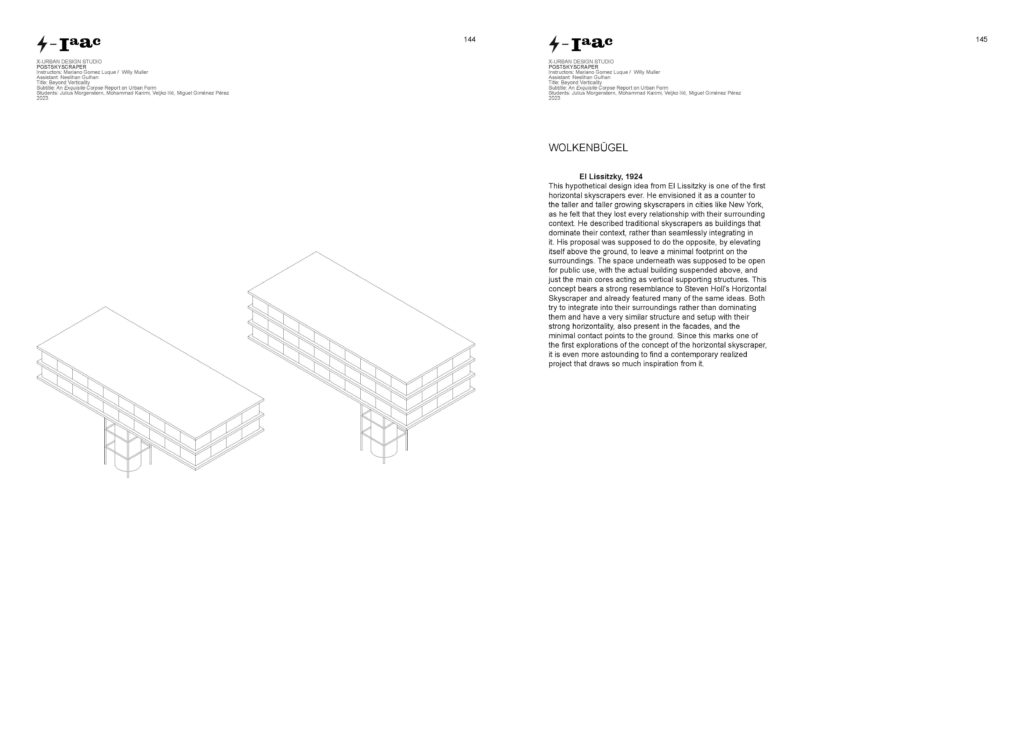
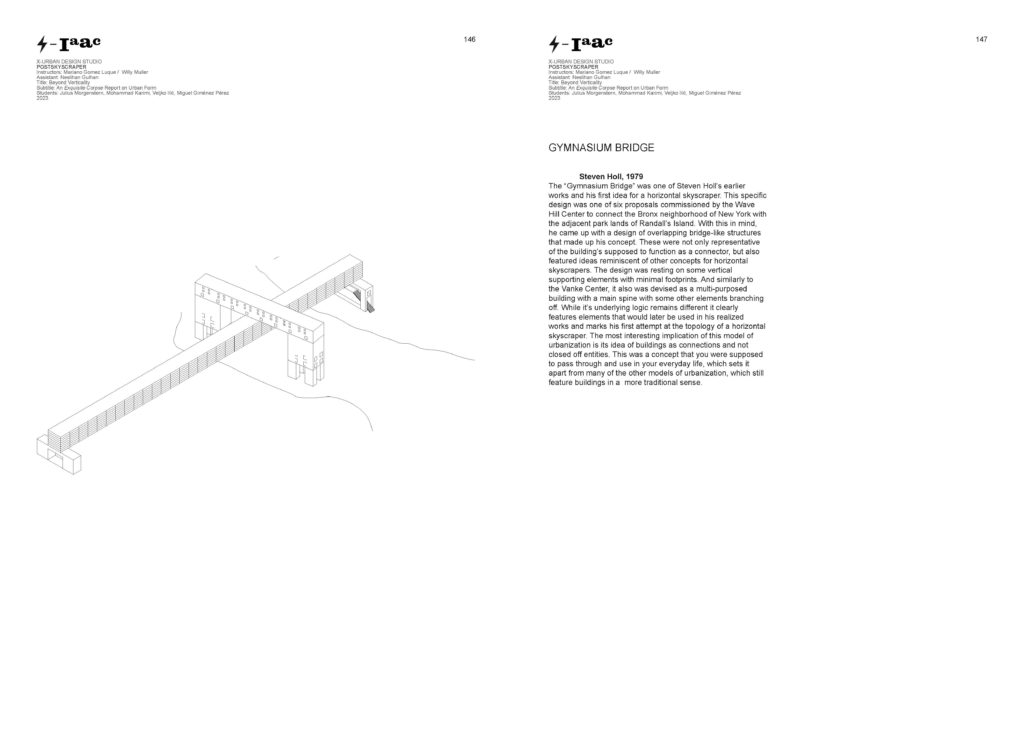
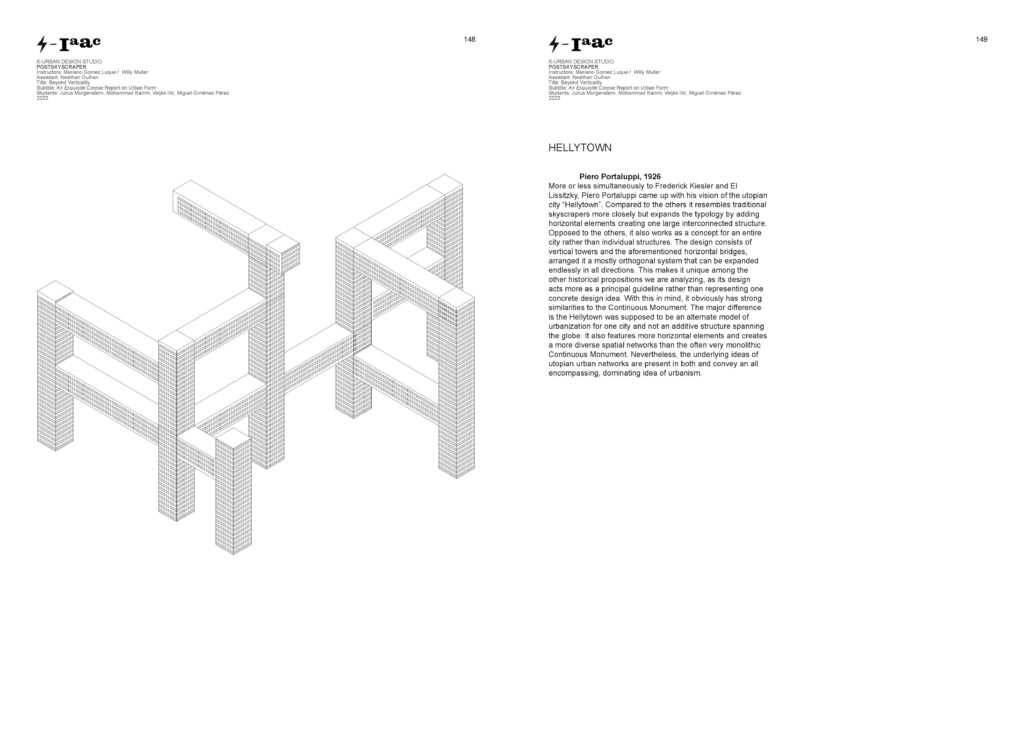
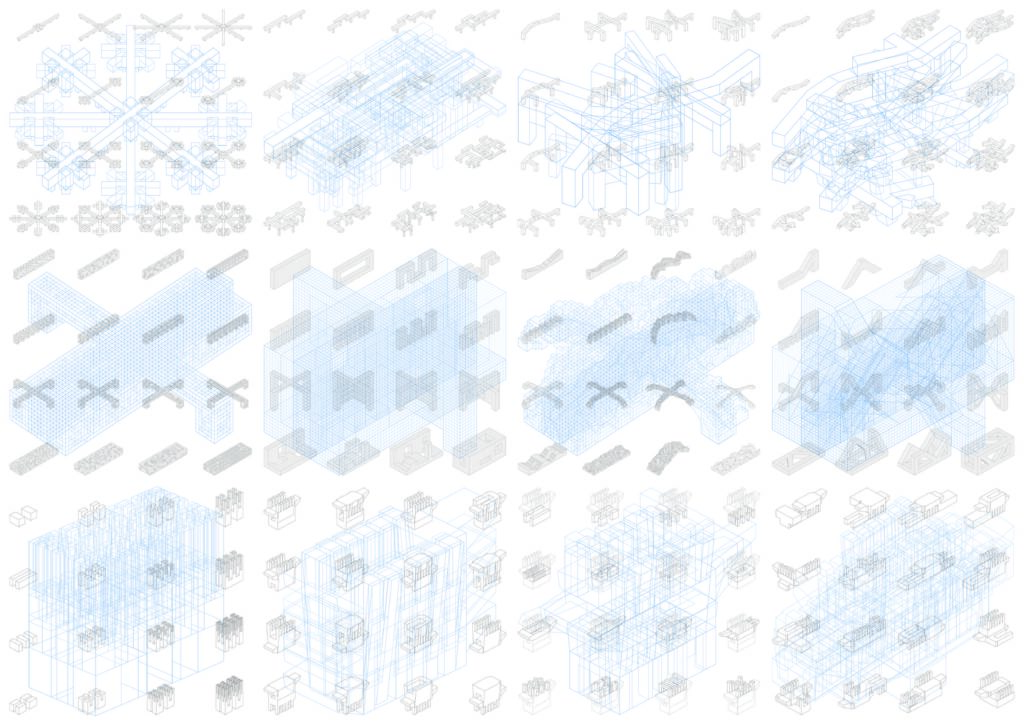
FORM-FINDING
Catalogues of the iterations
The aim of the task was the exploration of architectural forms and their possibility to transform and assemble. The outputs are the catalogs showcasing the broad spectrum of iterations. As the base forms we further altered, we used previously analyzed case studies.
In the first step, we explored the possibilities and alterations of the form of a Horizontal Skyscraper. To guide our remodeling efforts, we drew inspiration from various conceptual projects that shared the same idea of horizontality. The first step in our process was to familiarize ourselves with the conceptual projects, and after the analysis, we began the process of iteration. The strategy implied creating a series of models, each building upon the previous one and incorporating new ideas and alterations.
The second part explored modularity on an urban scale, intending to create extra-large structures. To achieve this, we used four forms of the Continuous Monument as a base: line, arch, cross, and voids in a volume. By rearranging the modules, we explored concepts such as oblique, verticality, voids, and landscape. The iterations showcase the possibility of having differences using a singular cube module.
During the third exploration, we scrutinized the relations between the masses and the voids using an example of the Atlanpole. First, we divided the Atlanpole into four main parts: the massive base, the void, the protuberances, and the towers. Afterward, we investigated the functional aspects of
these architectural typologies by reassembling and reshaping the individual segments and exploring the possibilities of the branching and the mixtures.
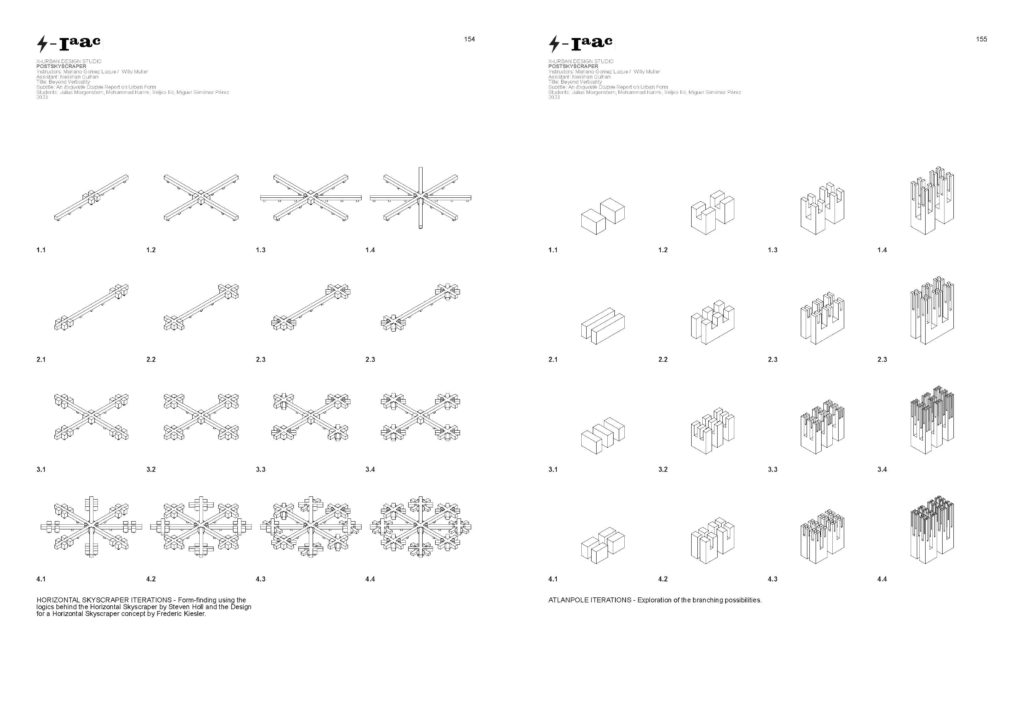
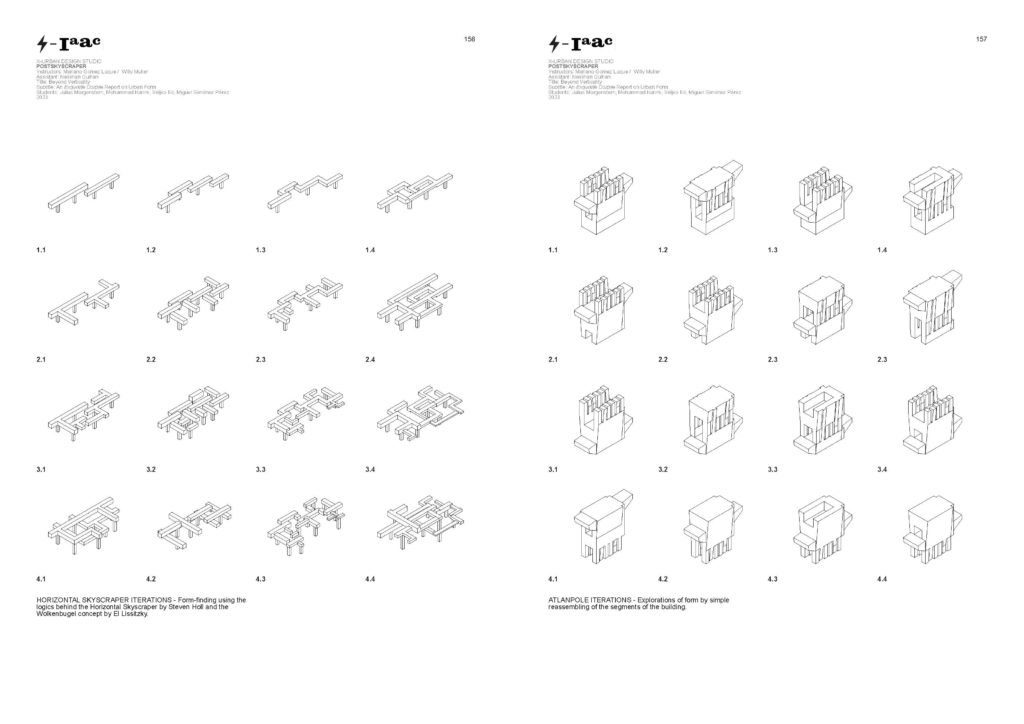
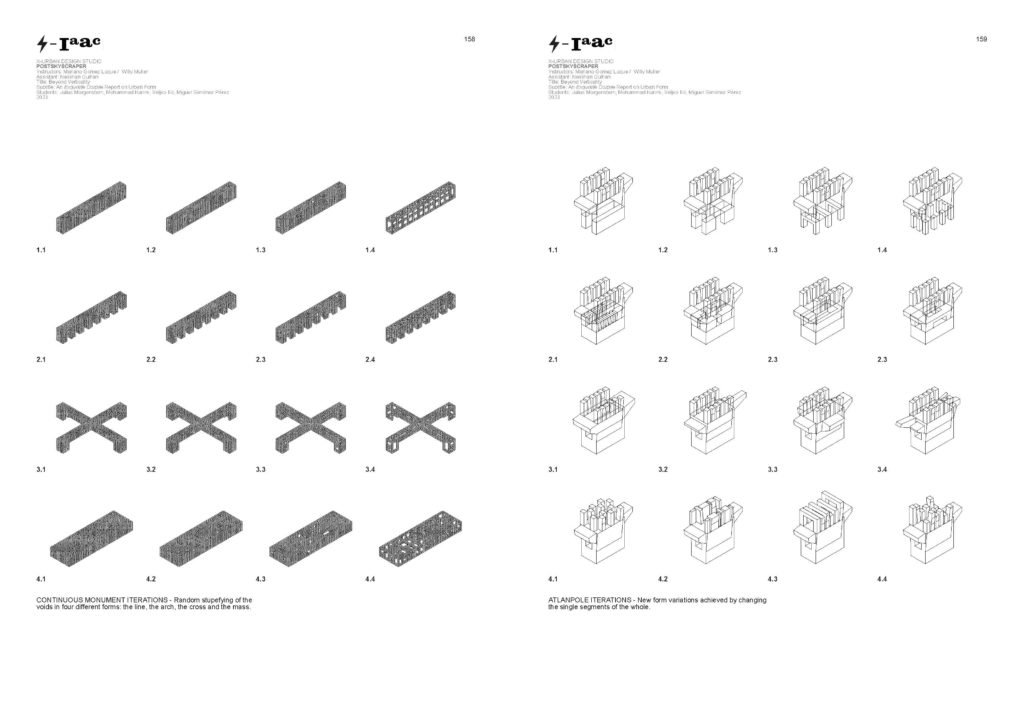
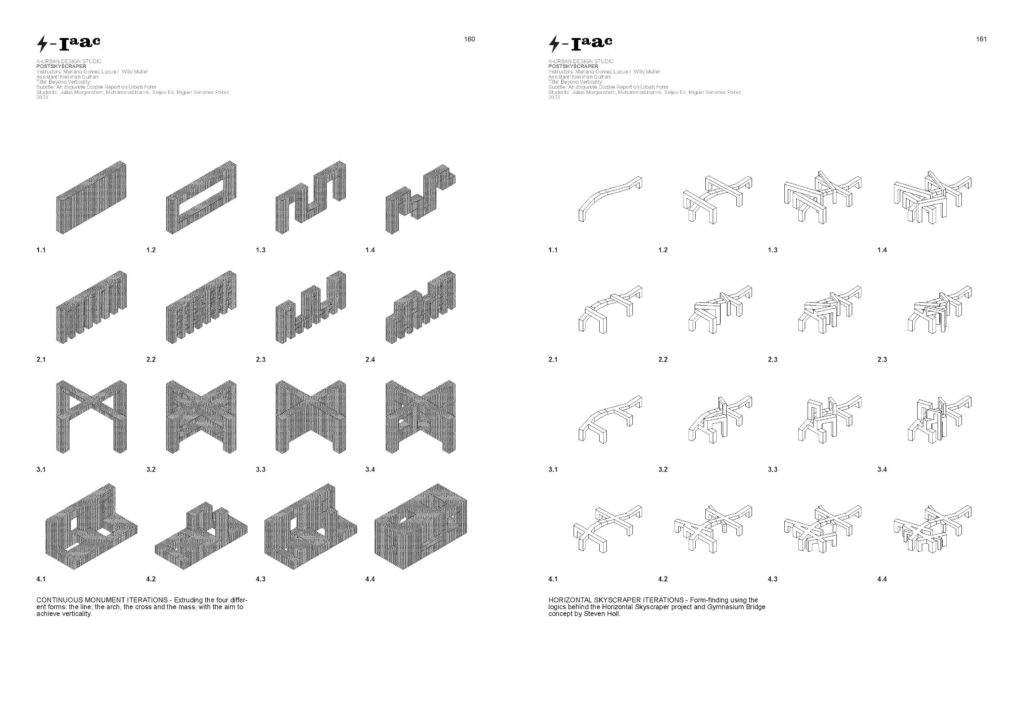
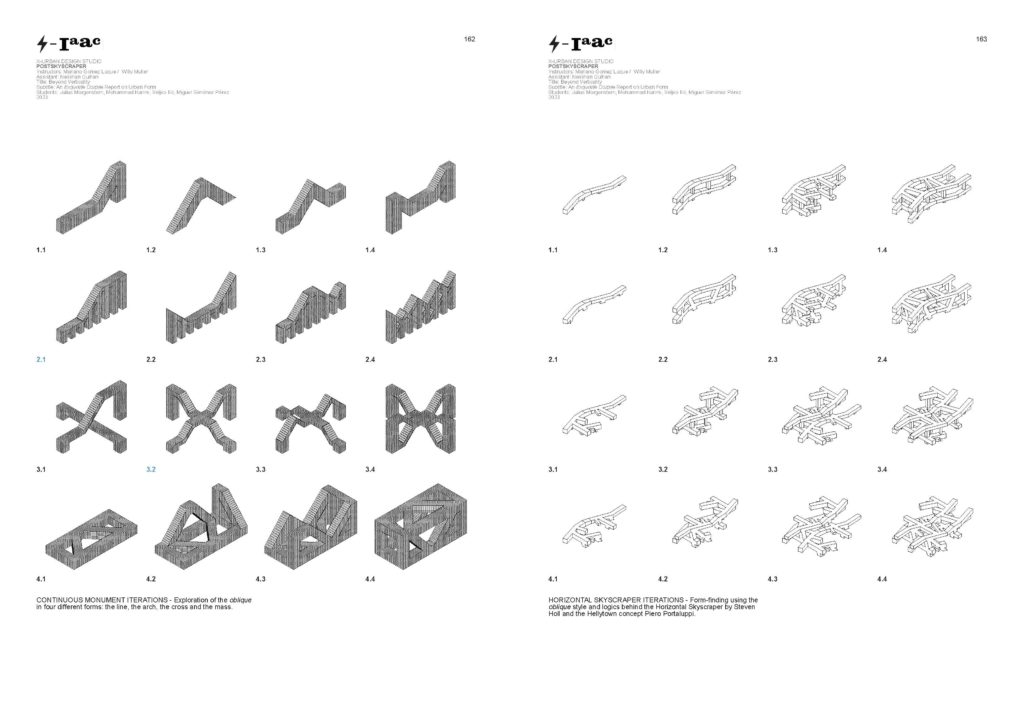
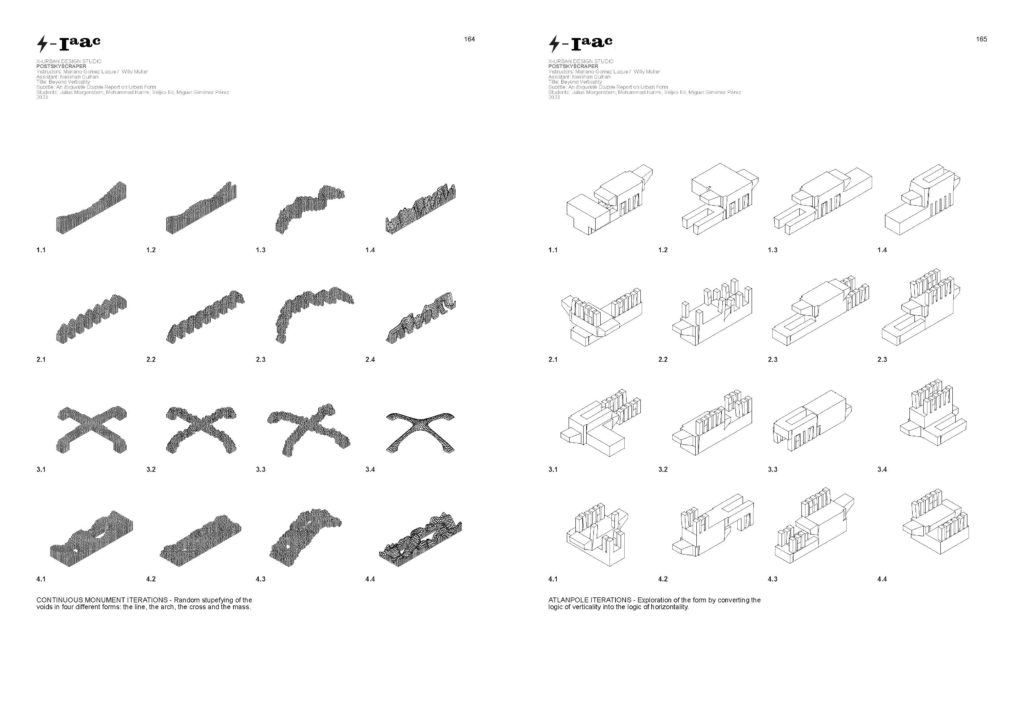
ARTIFICIAL SYMBIOSIS
Interposition into the environment
Importing the Continuous Monument iterations into the environment of that time, Superstudio designers created thought-provoking collages that challenged conventional thinking. In the manner of Superstudio, we recreated the Continuous Monument collages by utilizing modular iterations
and importing them into different contemporary environments. We created collages that not only pay homage to Superstudio’s legacy but also question current social and urban problems. Through our work, we highlight the need for new approaches to architecture and urban planning that consider modern society’s complexities.


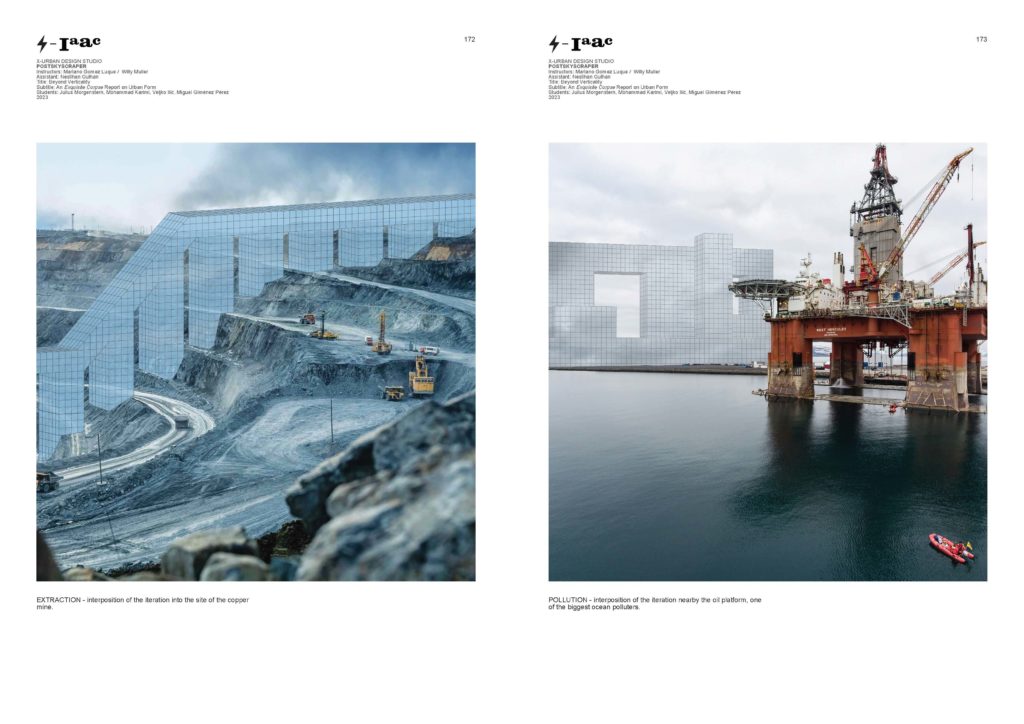
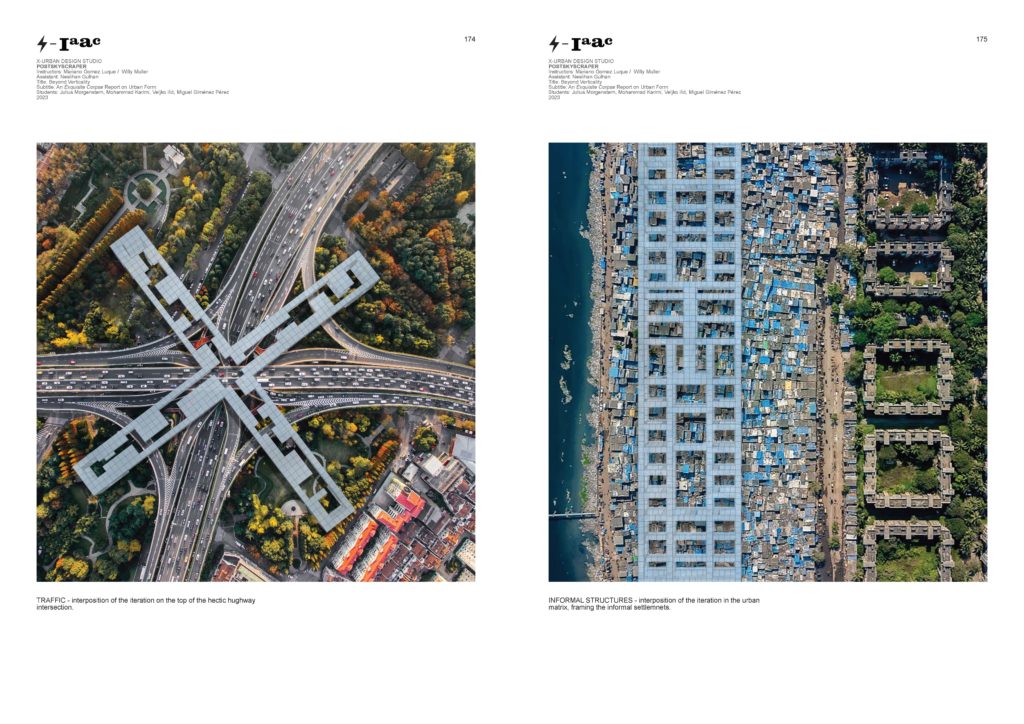
SUPERIMPOSITION
Overlaping the itertions
In the architectural design process, iterations are essential for creating new and innovative forms. In our recent project, we took this process a step further by overlapping iterations to produce new abstract forms. The beauty of this process lies in its simplicity. By layering iterations on top of each other, we created a diverse catalog of new abstract forms we could use in our work. But beyond the aesthetic value of these new forms, we also gained insights into the differences between the achieved iterations. We saw how subtle changes in the design process could significantly impact the final result.
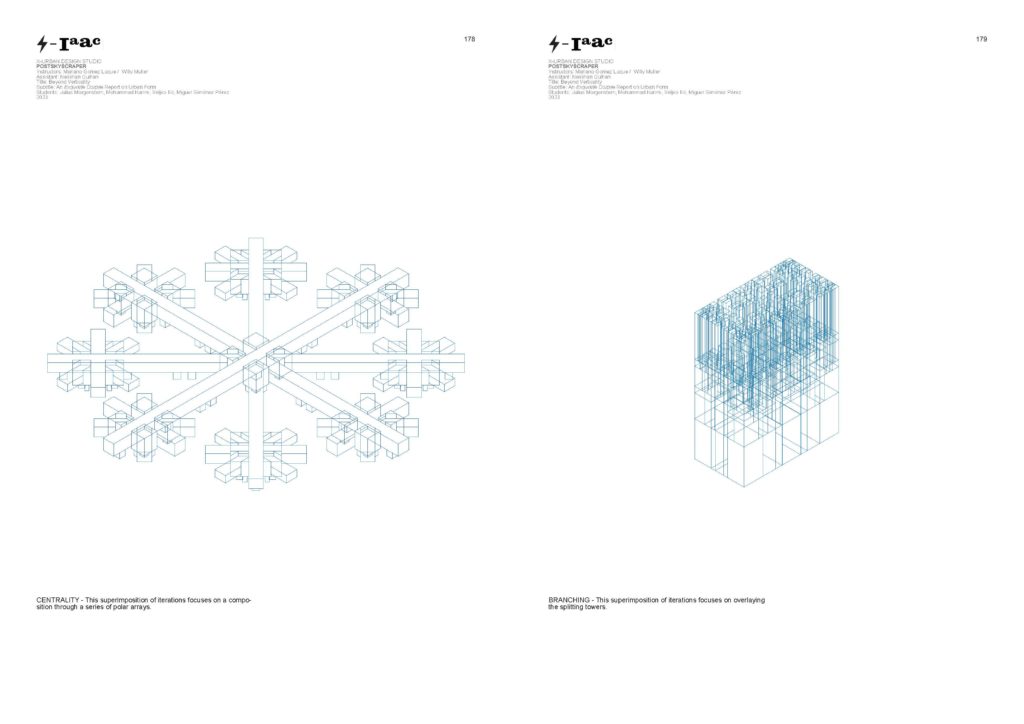
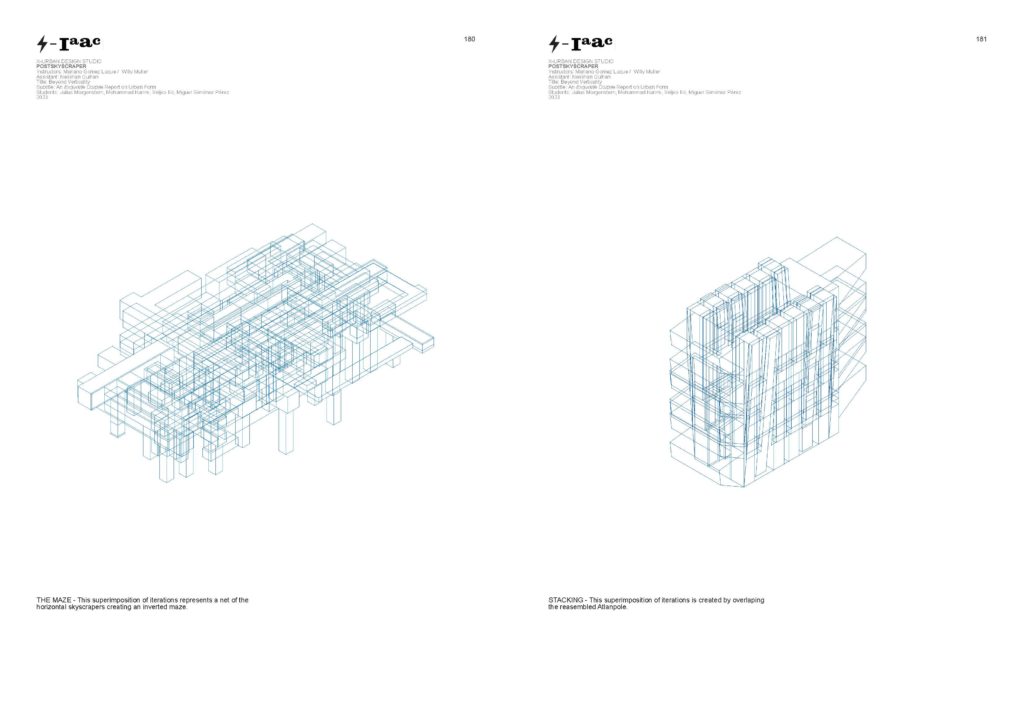
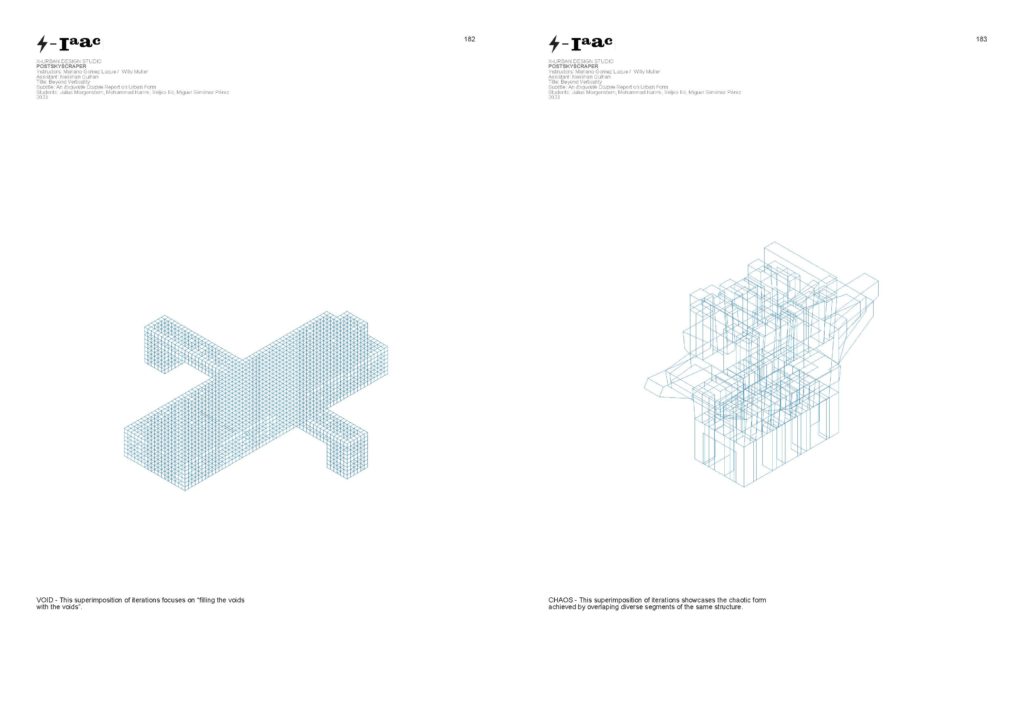
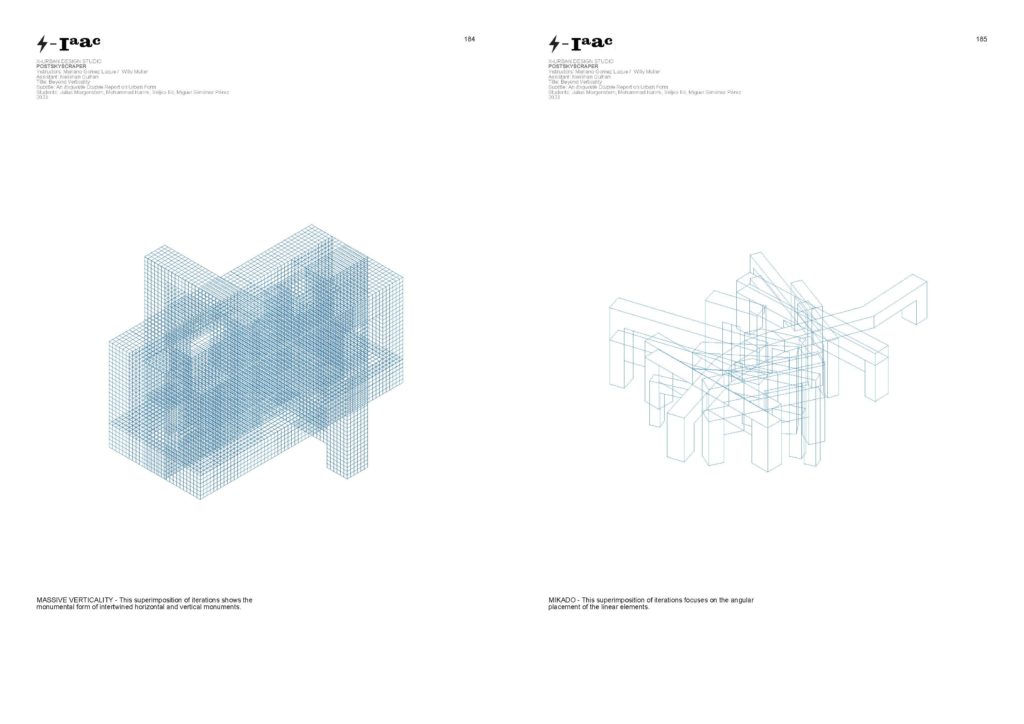
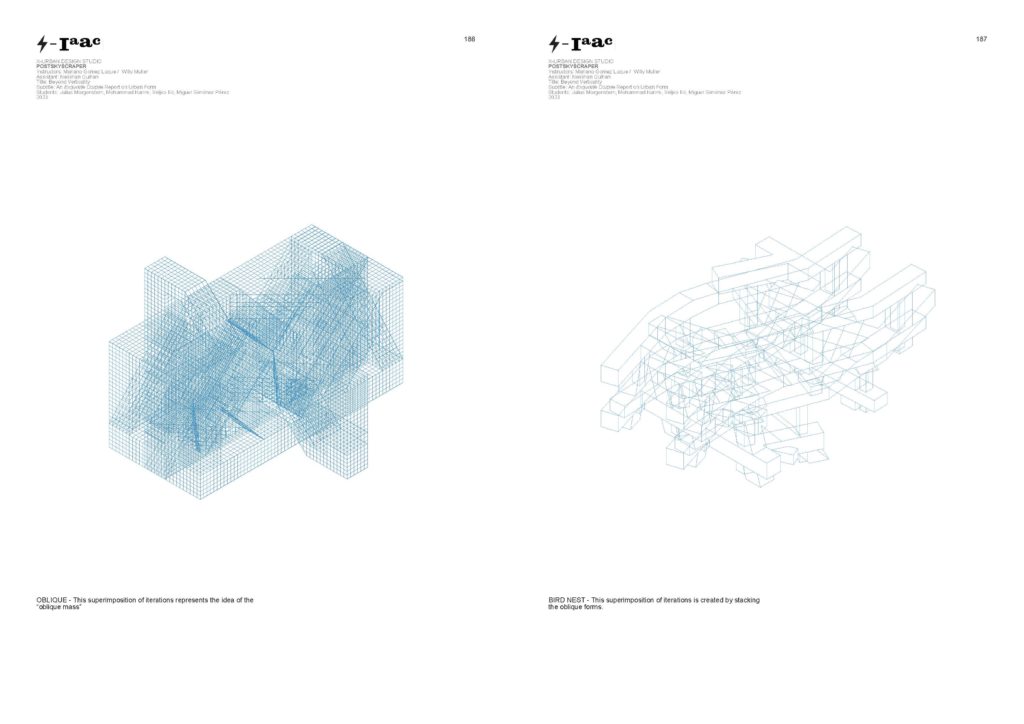
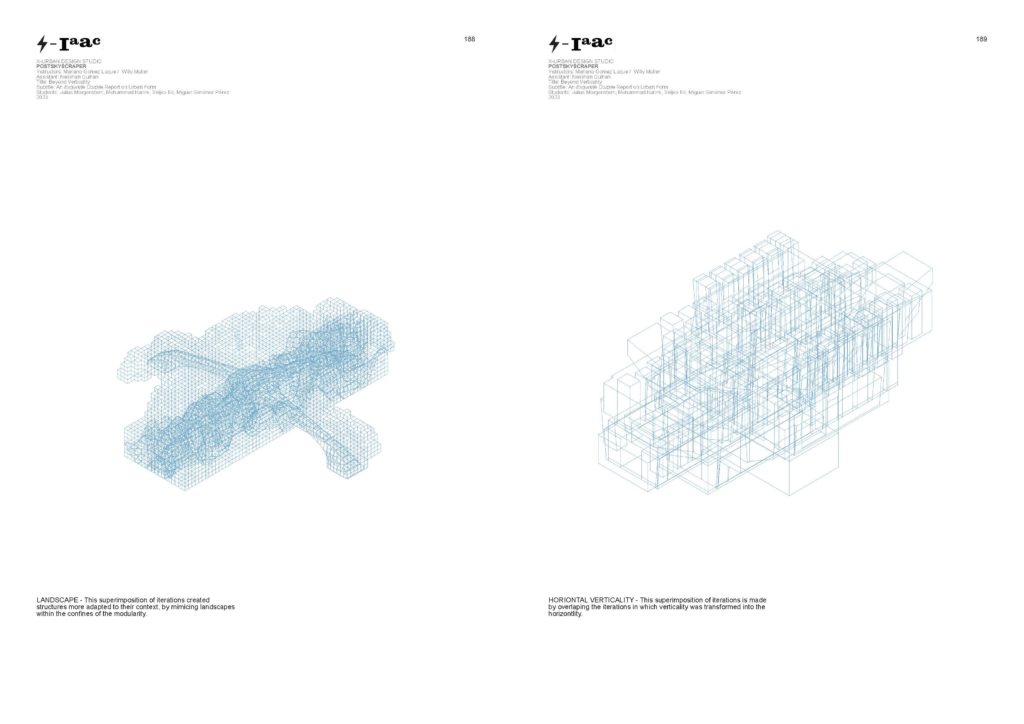
MEGAIMPOSITION
Superimposition of the superimpositions
During this particular step, we focused on advancing our research to explore more innovative ideas. This step was crucial in our creative process, as it allowed us to synthesize all of our thoughts and bring them together into a cohesive and compelling final product. We aimed to create abstract and chaotic forms, going beyond the mere overlaying of the segments and instead layering multiple superimpositions on each other. Our ultimate goal was to create a unique and visually striking masterpiece that could represent the culmination of our entire process – Megaimposition.
